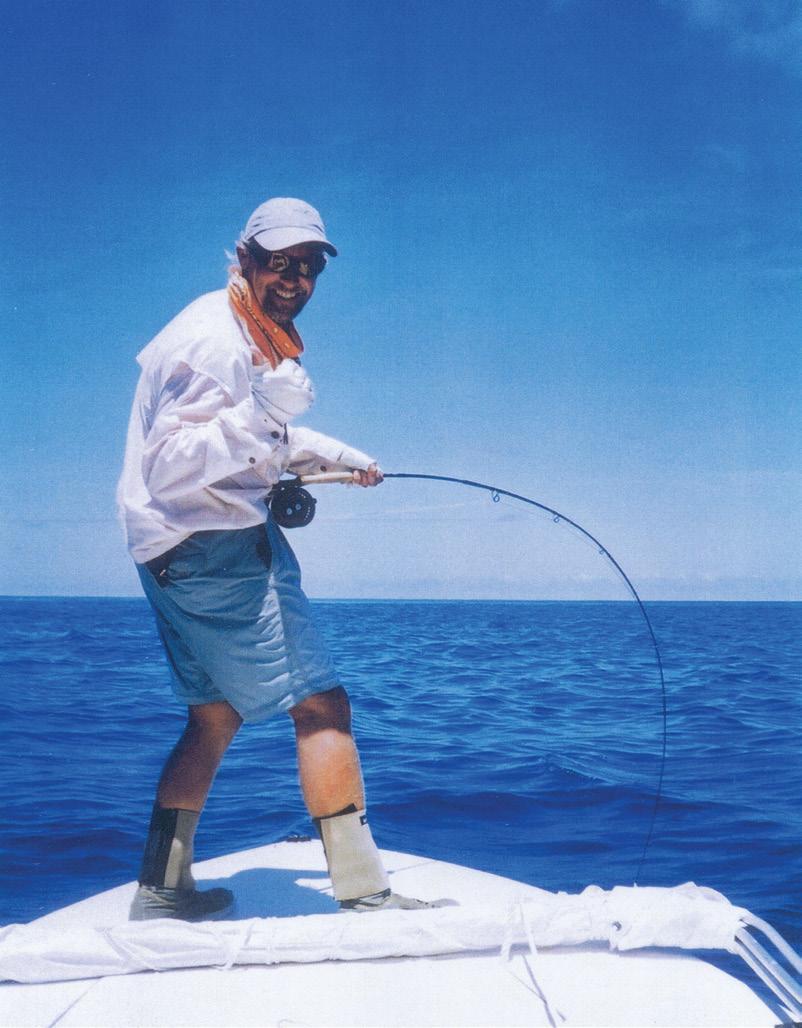

WAYNE’S WORLDS
WAYNE HASELAU, SAMBURULAND YELLOWFISH, TOUCHY FEELY IN MONGOLIA, MOOI GUERILLA BROWNS, BOOZE, BEATS AND MORE

CLEARLY INNOVATIVE.



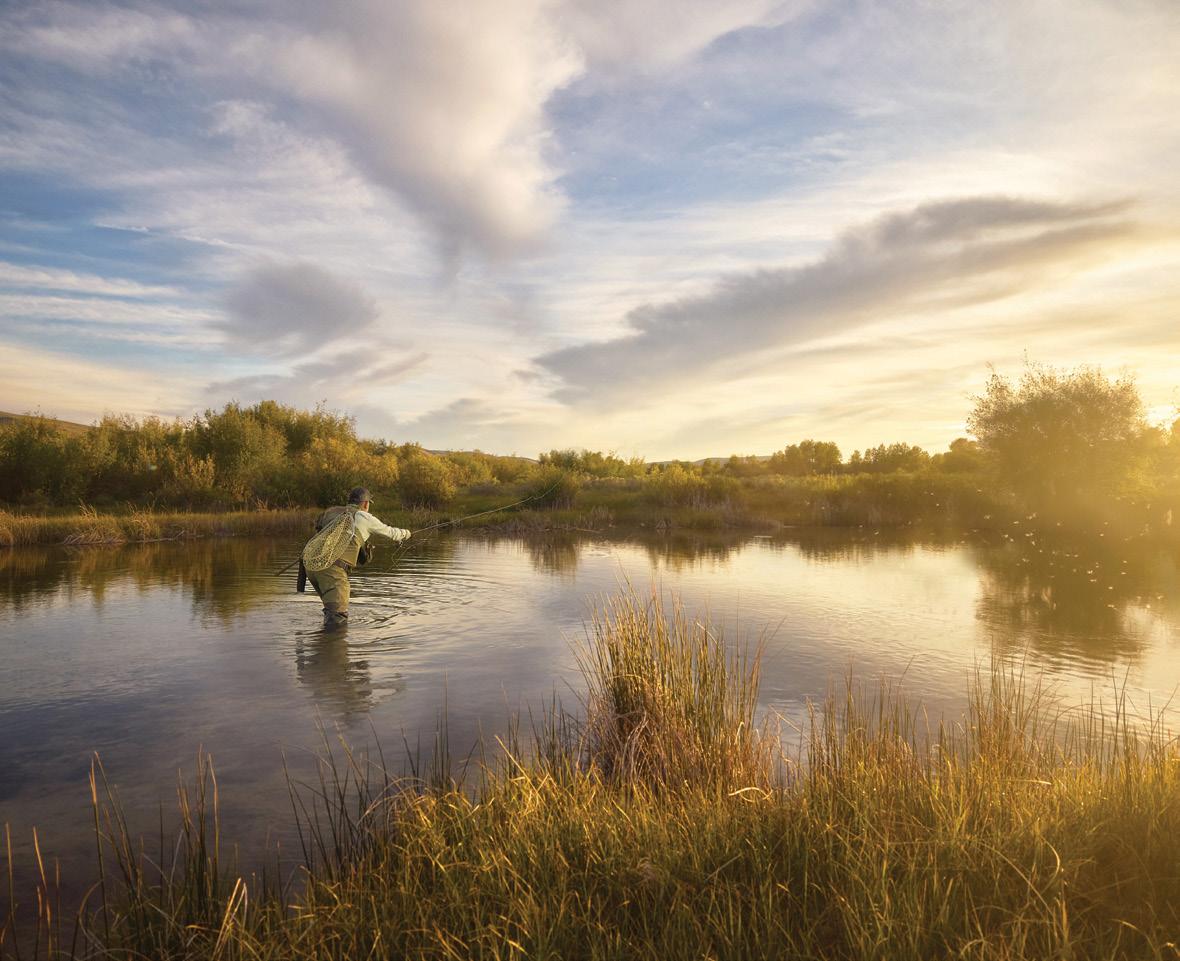





Introducing Magnitude Clear Trout oating line. A specialty line for the moments when you need to be stealthy and precise.
Go ahead, shorten your leader, throw the perfect cast and know you’ve got the right line to reel in that elusive trout.
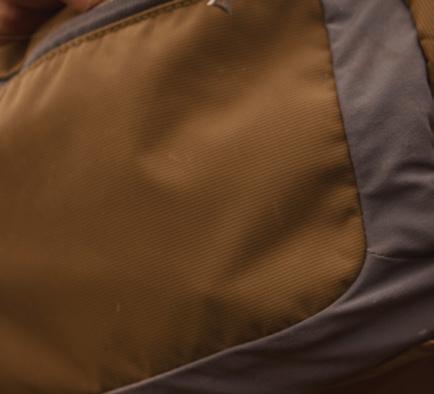
Duracoat
Specialized dual-polymer design optimizes line stiffness, slickness, and abrasion resistance while significantly reducing line memory and tangles.
EST +
EST+ - proprietary slickness additive that provides unmatched durability, smoother shooting, and eco-friendly performance.
Clear Floating Technology
Clear Floating Technology uses naturally buoyant polymers for the ultimate in stealthy presentation and best-in-class durability.
Traverse Zip-Front

For mobility and versatility.
The lightweight Swiftcurrent® Traverse Zip-Front Waders are streamlined for long, overland approaches and technical wading in all environments. Rigorously tested and equipped with essential features, they are sturdy, comfortable and engineered for athletic movement in and out of the water. Plus, their durable water repellent finish is made without intentionally added PFAS chemicals.







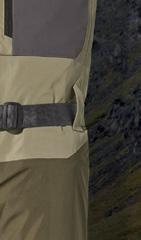
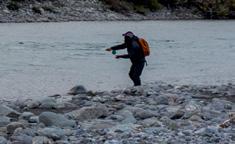

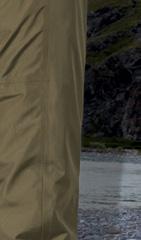


Traveling by packraft, Thad Ferrell, Sarah Tescher and photographer Andrew Burr paddled 45 miles of Alaska’s remote Kongakut River. Deep in the Arctic National Wildlife Refuge, the river’s wild Arctic char and grayling rarely see anglers. Photo: ANDREW BURR © 2025 Patagonia, Inc.
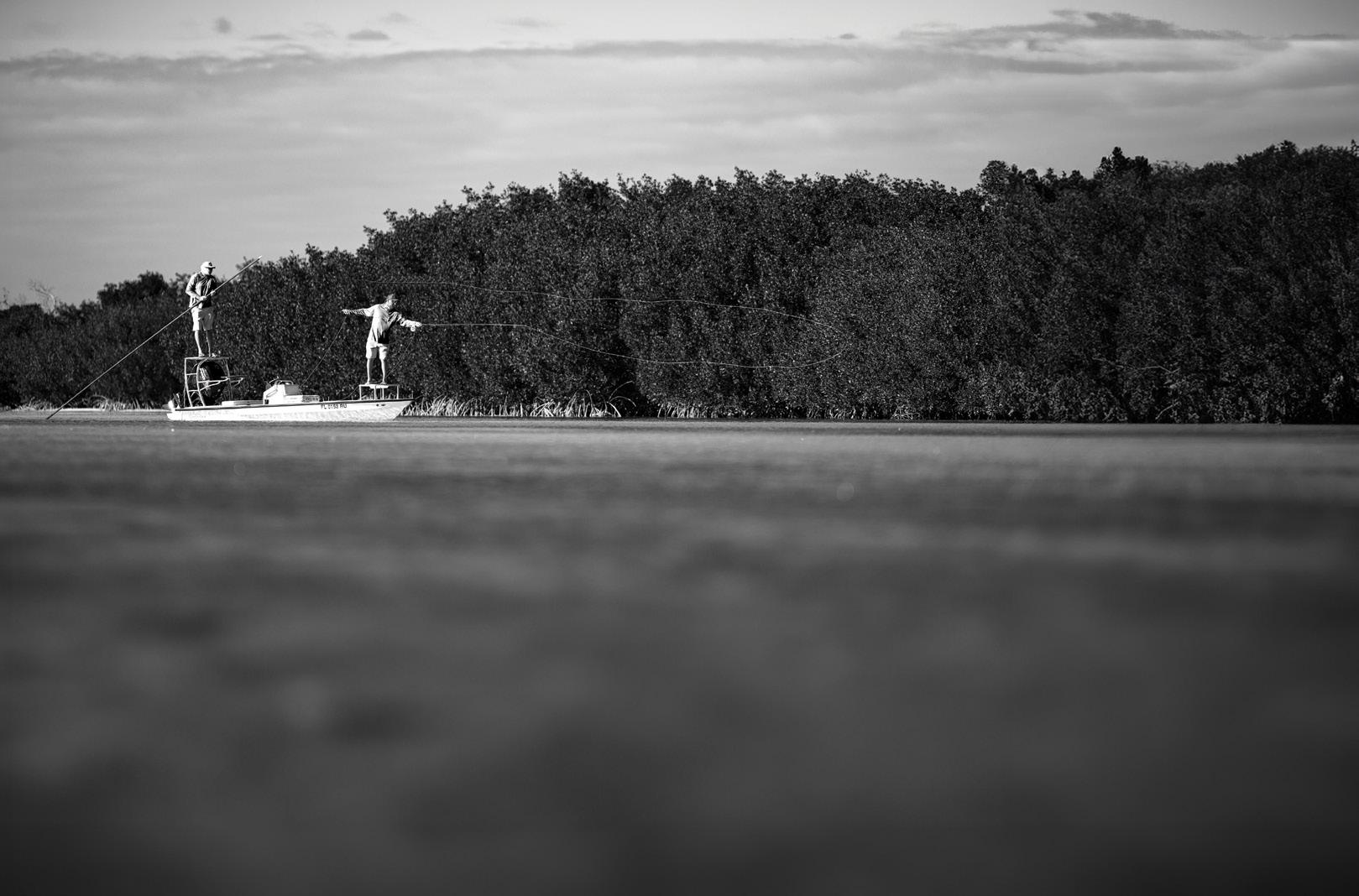
An easy-loading progressive action designed for ultimate versatility, whether lifting and aerializing heavy sinking lines, large weighted flies, or performing accurate floating line presentations. Introducing the new Exocett 88, relentless innovation, uncompromising performance.



28. RIGHT IN THE FEELS
How guide James Topham learned to stop worrying in Mongolia and love the bomb-ass cane rods of bamboo rod builder Brent Nickerson.
34. THE OFFICE
Invited to visit “WildFly country” (aka the Mooi River area around Nottingham Road), Tudor Caradoc-Davies goes to KwaZuluNatal to address some unfinished business with brown trout.
44. THE MAGIC JUNGLE
When not dodging flatdogs and throwing flies at Nile perch on Lake Turkana or the Murchison Nile, Andrew Nightingale likes to retreat to the Matthews Mountains of Samburuland where dry sand gives way to a wealth of water and waiting yellowfish around every bend.
56. WAYNE’S WORLDS
Low-key and unassuming, you’d be forgiven for not knowing enough about Wayne Haselau, one of the Seychelles’ and saltwater fly fishing’s great veteran guides. To remedy that we finally pinned him down to chat (amongst other things) about milkfish, triggers and clivias.
84. WANDS – ROD REVIEWS
The Mission has had some rods come through its doors recently, so we sent them straight back out again with our crew of contributors to test and best them in a three-part rod review.
Cover: Very demure, very mindful, Seychelles milkfish legend Wayne Haselau back in the day. Photo Vaughn Driessel
flats. Photo David Weaver.

ZOOM OUT
“He’s a clivia expert? That’s the ehrm...”
Bod, our art director, had just heard me explain that Wayne Haselau, the milkfish magician and fly tying guru behind the Pillow Talk and the Milky Magic (among other patterns) and one of the longest serving guides to ever work in the Seychelles, is now a well-respected clivia guy. Wayne had always had the plants in his life but pushed out of the Seychelles guide life after 20 years by the rinderpest-level generational changes of Covid, it dawned on him that clivias were the key to his future.
It was the way Bod said it, that made “clivia” sound like a part of the female anatomy that he had only heard of but would struggle to find.
Struggling to find things is a common theme for most of us I think. We struggle to find the balance between family time and personal time, hedonism and health, work and play. And, of course if quizzed most anglers I know would say that they struggle to find enough time to fish.
Wayne looks like he got that balance right. He lived the dream for the better part of the decades he spent in the Seychelles. You know, just wandering out on a flat on a day off and catching bonefish, GTs or what have you. Just like that*.
For others, that balance is aided by where they have decided to put down roots. Take Mooi River yokels Gareth George, Rhuan Human and Grevin Price who gave me a glimpse of their hyper-local fishing when I visited Nottingham Road to fish the Mooi. Of course when you are a visitor from out of town, you will always play that, “if this were my life” scenario, but I honestly believe if I lived there I would never get any work done I’d be fishing so much. Even if I only got to fish the Mooi right at the end of their river season, those lucky bastards have tons of epic stillwater access too.
For Kenyan wildlife guide Andrew Nightingale, it’s his connections across the country that gets him invites to littleknown oases like the Kitich Valley. “The what” you say? If you rumble northward across Samburuland’s semi-desert stretches, following the meandering subterranean sand rivers for a few hundred kilometres, you get to the Matthew Mountains and the Kitich Valley. There, the rivers reappear above the surface in a pristine jungle thriving with bird, insect and animal life and in those rivers there’s a population of yellowfish that thrives despite seemingly being so cut off from the rest of its labeo brethren elsewhere in Africa.

I am not an overly jealous chap. I don’t (or at least I think I don’t) see someone else with a fancy car or a nice house and think, “why do I not have that?” But something I do get jealous of - or perhaps envious is the better word - is people who have easy access to great fishing like all of these guys. With this back eddy thinking sloshing around in mind I was feeling a little sorry for myself while editing Conrad Botes’s Echo rod review in this issue. But when he referenced a bobber+heavy streamer technique he learned from the late smallmouth bass fly fishing guru Tim Holschlag, I did some research and had an epiphany. There on Tim’s extant website selling books, flies, caps and strike indicators was a book called Adventures of a Fishing Bum. The cover had two things that looked remarkably familiar - the terrain in the background looked exactly like the Tankwa Karoo and the angler standing on a koppie next to Tim was Conrad. I sent Conrad the pic and asked if he knew about the cover of Tim’s last book, published in 2017. He’d taken Tim fishing in the Karoo years ago but had no idea that that trip and this photo had been held in such high regard by Tim that it had made the cover of his adventure fishing book.
Perspective is a funny thing. Sometimes what you are looking for - balance, fishing... clivias, is right under your nose.
* Of course, it’s not ‘just like that’. There’s a vast amount of work, sacrifice and hardship involved (especially in the early days of the Seychelles scene) before a guide gets a chance to fish. But still...



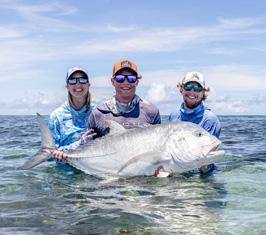

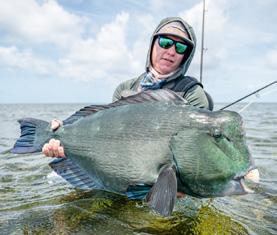



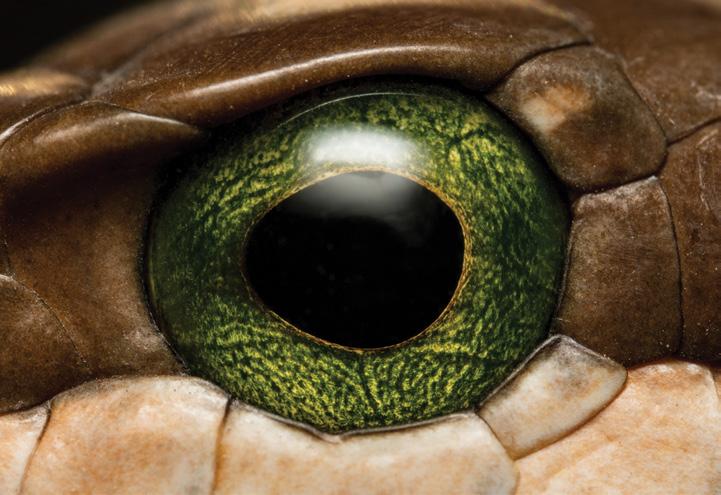
EDITOR
Tudor Caradoc-Davies
ART DIRECTOR
Brendan Body
EDITOR AT LARGE
Conrad Botes
CONTENT COORDINATOR
CONTACT THE MISSION
The Mission Fly Fishing Magazine for Soutie Press (Pty) Ltd 25 Firth Road, Rondebosch, 7700, Cape Town, South Africa info@themissionflymag.com www.themissionflymag.com
Matt Kennedy
COPY EDITOR
Gillian Caradoc-Davies
MANAGING DIRECTOR
Ingrid Sinclair
ADVERTISING SALES tudor@themissionflymag.com
CONTRIBUTORS #52
Fred Davis, Brett Bellairs, Andre van Wyk, James Topham, Andrew Nightingale, Jazz Kuschke, David Taylor, David Weaver, Wayne Haselau, Platon Trakoshis, Nick van Rensburg
PHOTOGRAPHERS #52
Fred Davis, Brett Bellairs, Andre van Wyk, Ryan Janssens, Andrew Nightingale, Patrick Nightingale, Jazz Kuschke, David Taylor, African Waters, David Weaver, Wayne Haselau, Platon Trakoshis, Josh Hutchins,
Ol’ beady eye. When he’s not guiding or cursing the existence of brass beads in fly tying, our High Fives guide David Taylor is a macro photography nerd as evidenced by this stunning shot of a boomslang’s eye.
Some mornings start with knots, not clocks.
There’s peace in the ritual. Fingers working through old muscle memory, wrapping tippet and thought into something that might fool a fish. Might not...This is where the day begins.
Full of promise.
We have the tools to make your mornings smoother.










CHUM
FLY FISHING FILMS GALORE, TFO IN SOUTH AFRICA, THE ULTIMATE AFRICAN FLY FISHING AWARD, A MUST-TIE BONEFISH FLY AND A TIGERFISH FISHERY THAT SHOULD BE ON YOUR RADAR.

ENTER...
...THE FEATHERS AWARD 2025 and win a one-way ticket into The Mission hall of fame (and maybe even Valhalla!). The Mission’s brains trust gets together annually to vote for the year’s most incredible fly-caught, African fish (evaluated on everything from size to rarity, difficulty and story). Have you or someone you know caught a phenomenal fish on fly on the African continent in the 2025 calendar year? To enter, send your photos and details to info@themissionflymag.com.

“A ONE-WAY TICKET INTO THE MISSION HALL
GET YOUR TICKETS FOR IF4…
WHERE YOU CAN WATCH the latest fly fishing films and be thrown into the raffle for R1 million in fly fishing prizes (including a trip to Alphonse Island). At the very least you can expect a great night out with mates including beers and all manner of fish porn, slow-motion eats, hero shots and storytelling from the likes of acclaimed directors like RA Beattie and characters like Paul Puckett. South African screenings are lined up for Knysna (17 July), Cape Town (22 July), Durban (23 July) and Joburg (24 July). quicket.co.za, flyfilmfest.com
THERE’S A NEW AFRICAN HOME FOR… …TFO AND CORTLAND. If you’re a South African Temple Fork Outfitters fan (and who doesn’t like the design DNA of Lefty Kreh and Blane Chocklett?), then you might want to take a gander at what Nottingham Road-based outfitters WildFly have in stock, as they now have the agency for TFO in Africa. You can expect to find the latest well-priced, hard-hitting TFO rod ranges, spares and all the after-sale service you need. WildFly have also taken over the Cortland fly line agency so whether you are looking for the 444 Classic, saltwater lines for GTs and tarpon, or a vast selection of other species and situation specific lines, WildFly is where you go. wildfly.co.za

UP YOUR NYMPHING GAME…
…BY TYING THE PERDIGON. Favoured ammo in most comp anglers’ fly boxes, Perdigons imitate a mayfly nymph and they sink quickly, allowing you to target the strike zone more effectively. In this step by step video, Protea Fly Fishing captain, Brett van Rensburg explains why Perdigons are one of his go-to flies for competition fly fishing in South Africa and overseas. youtube.com/@themissionflyfishingmagazine
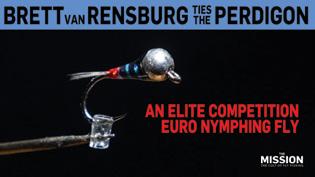
“FAVOURED AMMO IN MOST COMP ANGLERS’ FLY BOXES, PERDIGONS IMITATE A MAYFLY NYMPH AND THEY SINK QUICKLY.”
LEARN TO TIE THE PILLOW TALK…
…WITH WAYNE HASELAU, veteran Seychelles guide and the man behind one of the world’s most famous bonefish flies. A shape inspired by the classic Crazy Charlie and Clouser minnow, the Pillow Talk has a UV-resin protected body (which also adds dimension to the fly) and a red hotspot which acts as a trigger. These features, in combination with the chartreuse-over-white calf tail, are what make the Pillow Talk such an effective bonefish fly, and a lethal flats search pattern in general. youtube.com/@themissionflyfishingmagazine


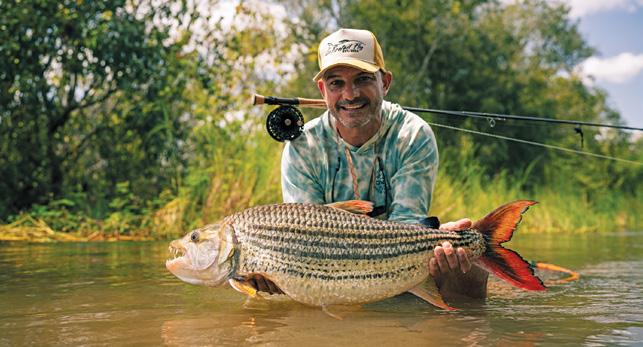
A FISHERY ON OUR RADAR...
...IS THE MALAGARASI RIVER WITH FIRETAIL FLY. Think Tanzania and tigerfish and you will likely picture the large Hydrocynus tanzaniae with its distinct blue adipose fin. But there’s more than one species of tigerfish in the country and in the rivers that run westwards towards Lake Tanganyika, like the Malagarasi River, where you get Hydrocynus vittatus, the same tigerfish species that you find in the
Zambezi or Pongola. But in the Malagarasi they get big, really big. Stu Harley (formerly with African Waters) who, despite the youthful looks, has many years guiding across Africa notched on his belt, is running his own operation there called Firetail Fly. Judging by how quickly his first slots got booked up, you might need to plan quite far ahead for your shot at these massive tigers. firetailfly.com
“IN THE MALAGARASI THEY GET BIG, REALLY BIG.”

TOM BECKBE DROPS...
...A CLASSIC FLY FISHING SHIRT. Alabama-based outdoor clothing experts Tom Beckbe have just released their Spring 2025 collection and the subtle standouts are the Tidewater long-sleeved and short-sleeved shirts. If you hate the way sun hoodies look (and the way they cling to your boepens) and want a lightweight outdoor shirt that is as suited to fly fishing as it is having a drink at the bar or meeting the missus for lunch, this lightweight, breathable, quick-drying classic is it. Made from a cotton (62%)/nylon (35%)/spandex (3%) blend with UPF30+ sun protection and pleated chest pockets, you can crush meetings in the morning and fish the hatch in the afternoon. tombeckbe.com
“CRUSH
MEETINGS IN THE MORNING AND FISH THE HATCH IN THE AFTERNOON.”

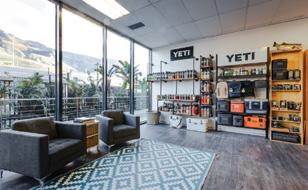


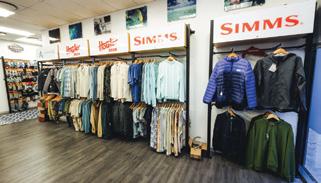

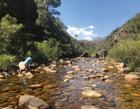
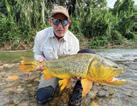



CAPE STREAMS
CAPE TOWN
BOLIVIA
THE BEATS
BRETT BELLAIRS - THE ULTIMATE
CAPE TOWN SLASHIE’S - SKALOVING BEATS
Photo Matt Kennedy
Brett Bellairs is a man of many hats. Lead guitarist for Cape Town-based punk rock band LLSO, when he’s not shredding the strings and screaming backup vocals to renditions of Rancid’s “Time Bomb”, Brett manages and curates 131 A Gallery – a contemporary art gallery – in Woodstock. Arguably Cape Town’s most successful indie gallery, 131 A Gallery features artists like Kirsten Sims, Michael Amery and The Mission’s very own editor-at-large Conrad Botes. Aside from selling art and fingering guitars, Brett makes the time to hassle the resident carp and bass at the local university dam and the elusive leervis in the less rancid sections of Zandvlei estuary.
Tell us about your home waters.
In the last couple of years I’ve become a bit of a Vlei (Zandvlei estuary) Rat in the summer months. Who doesn’t love the tug of a chunky leerie? In the other seasons I mostly try and get out on the Cape streams, to secret bass dams in the Elgin area. and to get stuck into the carp and bass action at the University of Cape Town’s dam five minutes from my home. I also try to get out to the Tankwa Karoo once a year or so, when work/life permits.
Did you ever think that A) you’d be the lead guitarist of a punk rock band, B) run one of Cape Town’s best indie art galleries, or C) be “man who eats boerewors roll” halfway through an Orange River video by The Mission?
A) Music has always been a big part of my life and I’ve been pretty fortunate to have played in some amazing bands over the last 30 years. The guitar thing is pretty recent (last six years or thereabouts) as I used mostly to play drums. I’m completely self-taught so I wouldn’t say I’m any good, but writing songs and playing guitar for LLSO is definitely my creative outlet.
B) The gallery stemmed from doing a bit of side-hustle art dealing around 10 years ago when my old magazine business wasn’t making enough money to make ends meet. An art collector mate had a vacant retail unit in Woodstock and 131 A Gallery was born. It’s been six years now and the business has grown massively, currently taking up most of my time.

C) I’m never going to live that one down, am I? I’ve always been crazy into fishing. I think it’s a gene that you are born with. You either fish or you don’t get it at all. I started fly fishing when I grew up in KwaZulu-Natal and my dad was getting into it. When I was about nine or 10 he used to take me to Kamberg, the Mooi River and a few other spots, mostly to keep me out of trouble at home. I was helluva naughty. I had a bit of a break for 10 years when I moved to Cape Town in 2001, and then rediscovered my passion for fly fishing after being coaxed back into it by Bod. (The Mission’s art director).

What are your musical influences?
I listen to quite a wide variety of genres of music, ranging from jazz, hip hop and blues to older punk rock, ska music and have even been known to delve into a bit of old-school metal and drum and bass. I do most of the songwriting in the band I’m in and I’d say our main musical influences are Rancid, The Clash, The English Beat and Motörhead.
Press Play

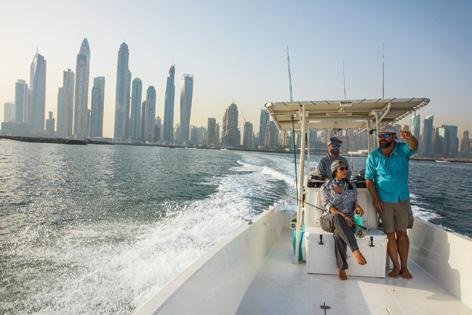
Whether in transit to somewhere else or visiting Dubai itself, where else in the world can you catch epic queenfish in an urban fishery in the morning, then sign that big deal in the afternoon? Or get 18 holes on a championship course, go for a helicopter ride/ desert safari/skydiving or go to the top of the world’s highest building...







In saltwater flyfishing’s new frontier, Ocean Active Fly offers anglers a chance to chase Trachinotus Africanus, aka “the 4th permit” along Oman’s stunning southern coastline. Expect experienced guides top tier boats and tackle, plus 4 star hotels and modern facilities. Visit OCEANACTIVEFLY.COM to book your trips now Email: charmaine@oceanactive.com @oceanactivefly
BOOZE AND MUNCHIES
THE MUNCHIES - MACKEREL TACOS
When he’s not making fly fishing videos, or talking about fly fishing, in his spare time The Mission’s content coordinator Matt Kennedy goes… fly fishing. Sometimes that results in fresh fish for dinner.
“I live in the Deep South, an hour away from Cape Town city centre, below the lentil curtain, an invisible boundary separating the vegans, surfers and all manner of hippie from the rest of society. Having False Bay on my doorstep, previously famous for having the highest concentration of great white sharks in the world, means that I can easily pop out on my Aqua Marina Atlas SUP for a session whenever the weather allows. (Apparently, due to orca predation, the sharks are now gone.) One of the many critters willing to eat a stripped Clouser is the feisty Atlantic mackerel ( Scomber scombrus ) which patrols the reefs near Simon’s Town harbour. The odd bigger fish offers a decent fight on a 5-weight, and more so, offers a healthy oil-rich fillet for the pot or, in our case, the tortilla.”
Ingredients (serves 2)
• 2X 40cm mackerel, filleted with skin on.
• Asian slaw; incl. 2 carrots, ½ baby purple cabbage, handful fresh coriander.
• ½ cup mixed seeds; including sesame, pumpkin and sunflower seeds.
• Asian dressing (any combo of sesame oil, soy sauce, lime/lemon juice and other things like garlic, ginger, chilli or whatever you like).
• 4 soft-shell tortillas.
Method
• Shred the carrot, purple cabbage and coriander into a bowl.
• Dry fry the seed mix in a pan until toasted.
• Toss Asian dressing and toasted seeds in with slaw.
• Fillet the mackerel, leaving the skin on either flank.
• Fry the fillet skin-side down on a medium heat in a mixture of butter and garlic.
• Serve a handful of slaw onto a warm tortilla, topped with a mackerel fillet.
• Fold, wrap, serve and enjoy.
Note: You need to use fillets from fish that are at least 40cm fork length. Any smaller and the filleting becomes very finicky.




Usually we call any stream our giraffe-like art director Bod has dawdled through “Knob Creek”, but, in booze terms, the name is reserved for this marque that comes out of the Jim Beam stable in Kentucky. We’re currently loving their Small Batch Rye Whiskey. Hitting that balance between the vanilla-sweetness of a bourbon, with the spice of a rye, it’s got a phenomenal nasal-oral glide and ride of herby, caramelly, oaky, peppery goodness. Available at justlikepapa.com
THE BOOZE - KNOB CREEK STRAIGHT SMALL BATCH RYE WHISKEY
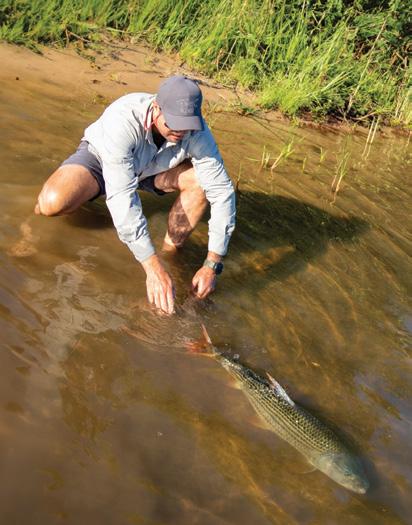





DAVID TAYLOR
SOFT
SPOKEN YET ARMED WITH A 12-WEIGHT FOR BIG FISH, A BEARD TRIMMER FOR SHAVING FLIES AND A MACRO LENS FOR SMALL CRITTERS, AFRICAN WATERS GUIDE DAVID TAYLOR MARCHES TO HIS OWN TUNE WHETHER THAT BE IN CAMEROON, LESOTHO, GABON OR SOUTH AFRICA.
Photos. Wade Kelly, African Waters
5 best things about where you guide?
1. Uniqueness. African Waters does this really well when picking destinations for camps.
2. Ecology. I get to guide in some of the last pristine environments left in Africa, and each destination is in a completely different environment with its own unique fauna and flora. In fact, just about the only environment I don’t get to play in is tundra.
3. The fish. Obviously. I get to guide and, occasionally, fish for some seriously cool species, each one requiring a different skill set and thought process to trick. It keeps it interesting
4. Doppel Munich. Lowkey best beer in Africa, no cap.
5. Not to be too cheesy but, the other guides. If we weren’t all constantly taking the piss, guiding would get old quickly. It’s way too much fun pissing off Riley.
5 fishing-connected items you don’t leave home without before making a mission?
1. My camera. Canon R6 Mark ii with the RF 24-105 F4L lens and a polariser. Oh and, of course, a macro lens (Laowa 100mm f2.8).
2. Dr Slick pliers on my belt.
3. Sun protection (sunglasses, cap, Buff, sunscreen).
4. Fly tying kit for anything that is more than one day.
5. Head lamp. It’s amazing how often a day mission ends after dark.
5 bands to listen to while on a road trip?
1. Tool.
2. Seether.
3. Falling in Reverse.
4. Whiskey Myers.
5. Drive By Truckers.
5 things you are loving right now?
1. Knife-making (I’m new and bad at it, but it’s the most exciting stage of a new hobby).
2. Photography.
3. Running.
4. Surf fishing.
5. Making sourdough bread. Apparently, I am being influenced by the tradwives on Instagram.
5 indispensable flies for saltwater?
1. Clouser (obviously).
2. Hollow bucktail flies, preferably with some ostrich mixed in.
3. White flipper.
4. Puma, usually tan.
5. Flexo. I never have the opportunity to use them, but I have to have them with me.
5 indispensable flies for freshwater?
1. Jig CDC bugger in either dark brown or black.
2. CDC collar tungsten PTN.
3. Tan puma.
4. Klippies en kolgans (CDC and Elk for our more civilised international readers).
5. A smallish tan DMA with a zonker tail. Like a #2 or #4 Ahrex salt jig hook. Not sure it really has a name but that’s the best description I have.
5 favourite fly fishing destinations across Africa?
1. Lesotho.
2. Kamberg rivers.
3. Faro River, Cameroon.
4. Gabon.
5. Ruhudji River, Tanzania.
“‘WOMP WOMP.’ WHEN A CLIENT LOSES A FISH BECAUSE THEY DIDN’T LISTEN.”

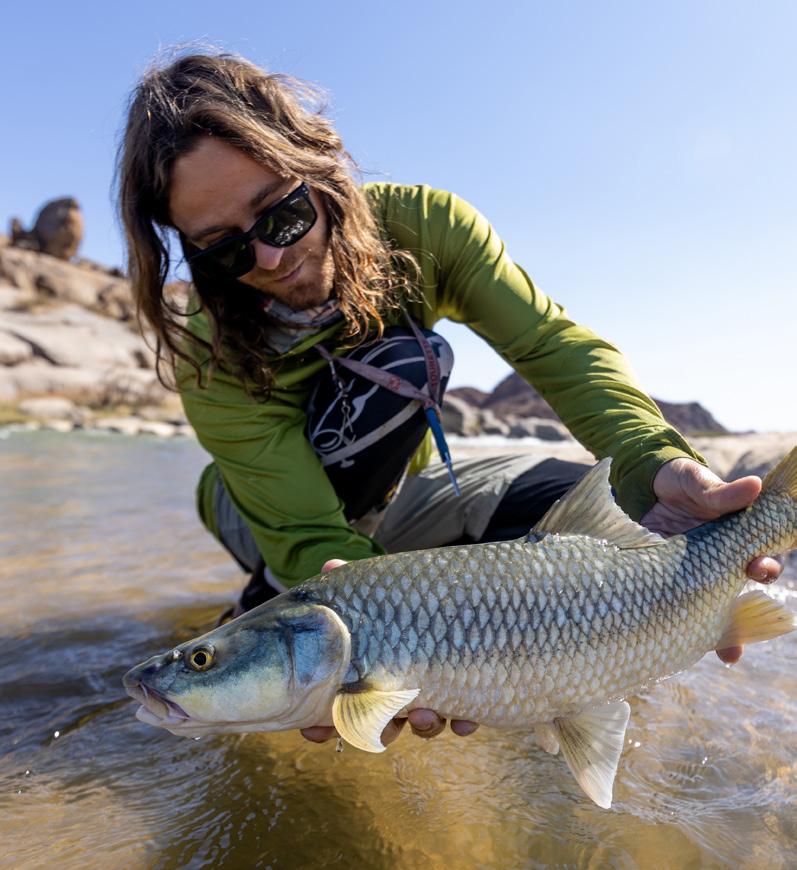



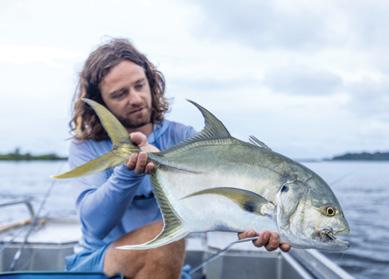
5 favourite fly fishing destinations globally?
1. Cameroon.
2. Gabon.
3. Czech Republic.
4. Gubu Dam or Kamberg rivers to be consistent.
5. Lesotho.
5 of the best things you have picked up from guiding?
1. Patience.
2. Photography. I was into it before, but I have learned a lot more since starting to guide.
3. An appreciation of small achievements. Stuff like successfully making a loaf of bread for breakfast in Lesotho. It’s a small thing, but the day is started with something already having been achieved and it sets the tone.
4. Rudimentary bush plumbing. Yes, it ain’t pretty, but it mostly works.
5. Improved problem solving. When you are building a camp in rural Cameroon and the nearest town is six hours away, you often have to think well outside the box to get things done and it’s oddly stimulating.
5 best subjects for macro photography?
1. Mushrooms. Yes, really.
2. Jumping spiders. I know that’s what everyone photographs, but they’re cool OK?
3. Snakes, especially their scales and eyes.
4. Scorpions. Unconventional, but I just like them. I realise that this is not normal.
5. Something else, although I promise it’s not that small. Some would say too big.
5 of the worst things you have picked up from guiding?
1. A small amount of French.
2. A toxic relationship with coffee.
3. Weird sleep patterns.
4. An inability to deal with cities and crowds.
5. A deep hatred of brass beads.
5 hints that your client is a colossal tool?
1. When the drinking starts with the morning coffee. To be fair, they can often be lekker, it just gets tiresome when an ou is never sober.
2. Boasting about keeping bakkie-loads of kob in Henties Bay in years past and then literally in the same breath blaming the Chinese trawlers for the current bad fishing in Henties. I kid you not.
3. Trying to tell me how to catch the fish we are fishing for on day one of the trip. Boet, it’s your first time here, please just listen. I promise I don’t want you to blank, but you’re trying hard to do so.
4. Refusing help while blanking. Usually linked to the point above.
5. Dropping a bunch of K-bombs. For internationals, this is the South African equivalent of the N-word.
5 people you would like to guide or fish with?
1. Jiri Klima, the nymphing GOAT. Sure, nymphing has advanced, but this dude was the OG comp nymphing god.
2. Matt Walsh. OK, most of you probably hate him, but he’s very funny in a deadpan way. I rate he could be great fun on a river.
3. Carl from the “Fish with Carl” YouTube channel.
4. Steve Rajeff. It would be amazing to guide a guy who could put a fly exactly where I want it every time.
5. Not guide or fish with, but I would love to tie flies with Rupert Harvey or the late Bob Popovics.
5 fish on your species hit list?
1. Golden dorado.
2. GT. I’ve technically ticked the species but 45cm doesn’t count.
3. Dorado (mahi mahi).
4. Bonefish. Believe it or not I’ve never seen one.
5. Poensie (black musselcracker) on fly. It must be possible.
5 of the most underrated species in your book?
1. Bluegill. Actually surprisingly fun sight-fishing big ones on a 3-weight.
2. Rainbow trout. They get a lot of hate from people who have fished all over, but whenever I get home I do look forward to some trout fishing. Watching a sight-fished wild trout come up to a dry will never get old.
3. Elf (for our incorrect KZN readers, shad). They are treated as a semi-trash fish but I love their aggression.
4. Longfin jacks. They don’t exactly get hate, but they are easily taken for granted in Gabon and they are actually an incredible fish on a fly rod by almost any metric. Just such a cool species.
5. Sharptooth catfish.
“I’D LIKE TO FISH WITH JIRI KLIMA, THE OG COMP NYMPHING GOD.”

5 destinations on your bucket list?
1. Bolivia.
2. Providence.
3. Chinko (Central African Republic).
4. Sudan.
5. Alaska.
5 things you would take up if you weren’t always fishing?
1. I have heard that there are these mystical creatures called “women” that one can get to know and maybe even marry. I would love to investigate this further.
2. Poverty. I studied biology. Big mistake.
3. A healthy sleep schedule.
4. Weekends. I remember something about weekends before I started guiding.
5. Maybe rock singing lessons.
5 essential ingredients for an incredible mission?
1. Isolation.
2. Pristine environment.
3. Like-minded mates.
4. Novelty.
5. Bare feet.
5 best Gen Z/Gen Alpha terms that could be used to describe the places you fish, the clients you have guided and the species you guide for?
1. “Main character energy” (tigerfish, jacks, tarpon, Nile perch).
2. “Bussin” (to describe Doppel Munich beer).
3. ”Very demure, very mindful” (usually to do with blending colours in fly tying).
4. “Yeet.” Very useful when describing casting a 12-weight sink tip line. You don’t cast them, you yeet them
5. “Womp womp.” When a client loses a fish because they didn’t listen.
5 common mistakes that most clients make?
1. Not getting casting lessons before a trip. Yes, I can help you with your casting, but it’s a really expensive casting lesson considering the price of the trip.
2. Line management. When I point out something that we are drifting towards, it means you must make sure that your line is not under your feet when we get there.
3. Brass beads. Brass is the most useless way of weighting a fly. If you want it to be lighter, use smaller tungsten beads. Brass beads should not exist. I will die on this hill.
4. Not reading the pre-trip information.
5. Trout-setting tarpon and tigerfish, but strip-setting Lesotho yellows.
Your last five casts were to…
1. Longfin jack.
2. Brown snapper.
3. Gorean snapper.
4. Elops sp. (ladyfish, springer, skippy – the West Africanflavoured ones).
5. West African spotted grunter.
UNDERCURRENTS RIGHT IN THE FEELS
HOW JAMES TOPHAM LEARNED TO STOP WORRYING IN MONGOLIA AND LOVE THE BOMBASS RODS OF BAMBOO ROD BUILDER BRENT NICKERSON .
Photos. Josh Hutchins
Iwas being extracted from my first season of taimen guiding for the Sweetwater Travel Company at their lower camp on the Eg and Ur rivers in Mongolia. It had been a hugely successful introduction and I was absolutely sold. I was in love. Without getting too far into the romantic drippings of my mood, I was in the same sort of rapturous state that one only gets after discovering your new favourite band, or kissing a very pretty girl for the first time. The only thing tempering my elation was the fact that I was on my way out, and not on my way in. For some reason known only to the god of camp logistics, the helicopter had to stop at the upper camp before heading to Ulaanbaatar. Upper camp still had one more week of fishing. I firmly believe that these things are decided by a silver-haired madman that sits atop an ivory tower yanking on levers that control steam-powered pistons. I don’t know. I’m just a fishing guide. I digress.
After touchdown we disembarked from the Russian flying tank to stretch our legs and, in doing so, I noticed a veritable thicket of bamboo rods leaning against one of the gers (yurts).
“What’s up with the cane rods?” I asked Matt Ramsey, the veteran guide by my side.
“That’s probably Brent Nickerson. He makes them himself. Comes here often. Only fishes with bamboo.”
I was immediately conflicted. On one hand I’ve always loved the idea of fishing an old school cane rod. There is the traditional aspect as well as the history: Halford and

Skues, etc. ... And, of course, all my fishing heroes have written about the soul and feel of a cane rod, as if it were a Stradivarius. You wouldn’t be wrong if you described me as being charmed by bamboo. At one stage, early in my guiding career, I thought building cane rods would be a lucrative and fulfilling way to pass the off seasons. I mentioned this to a mentor at the time who dismissed bamboo without hesitation. “It’s slow and heavy and it warps and it’s kak.” My little romantic idea of gently toasting, planing and binding bamboo on a wintery day while the fire glowed in my workshop, evaporated.
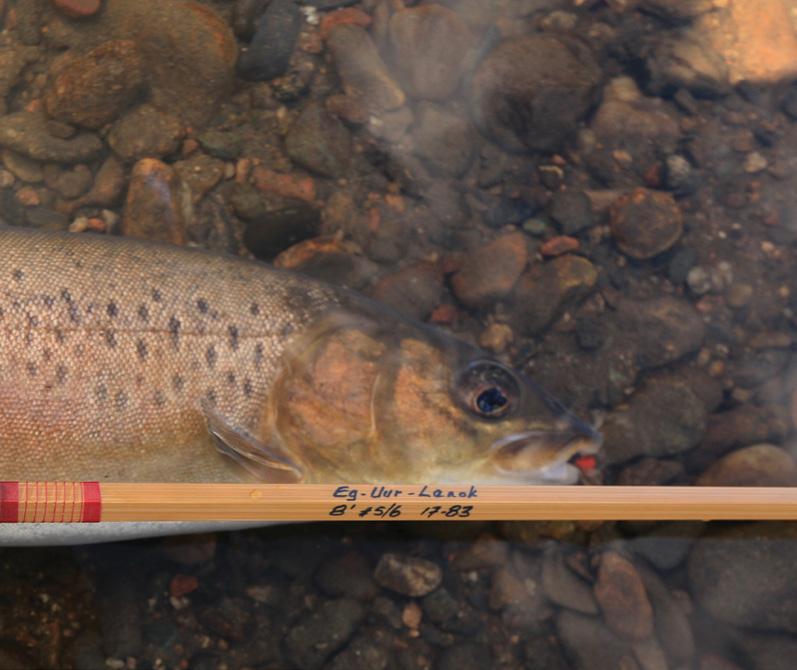
On the other hand, I had this abrasive irritability that caught me quite off guard, completely incongruous with my giddy mood at the time. “Why?” I thought to myself. “Why fuck around? You’re fishing for taimen – the largest salmonoid in the world. They eat ducks ’n shit (I’ve seen it). When a metre-and-a-half-long taimen T-bones your skated fly from underneath, breaching like a great white, you don’t want to be holding onto a quivering piece of floppy bamboo. I would want some space-aged, X-wrapped, designed-in-a-fallout-bunker-style hardware. Now if I was fishing for some lazy, limp, fetid, chalk-stream, pellet-fed, dry fly-sipping, pinky-sticking-out-from-thefine-china-cup, soft-ass trout, perhaps then I could get all cane-brained.
Look, I realise that is a lot to feel in a very short time and, after all, it is just a collection of bamboo fly rods is it not? Perhaps I hadn’t eaten enough breakfast or something, but that is honestly how I felt. This was before Thomas & Thomas were making saltwater bamboo rods and my contemporaries were catching big GTs and tarpon on them. It was also when fibreglass rods were coming back
into fashion with names like Fastglass, Bad Ass Glass and Butterstick and guys were catching huge musky and stripers and even permit with them. So I really shouldn’t have been irked by it. I suppose I have always been a bit slow with trends, or perhaps just a sceptic. And a sceptic I remained for some time.
And some time it was until I was back in Mongolia, this time based at upper camp. It was change-over day, mid-season. Being somewhat of a closet introvert, change-over days are my least favourite day of the guide week. The group that’s just left had become close friends and the group that had arrived were strangers whom I had to become acquainted with. Part of this complex ritual includes tackle setup. Guides learn very quickly what the upcoming week will be like during tackle setup. Clients take out their prized equipment, their beloved rods, reels and flies and lay them out at the guides’ feet nervously, apologetically, arrogantly, obsequiously, brazenly, you name it. Their personalities are laid bare and the guides read the strewn equipment like a witch doctor reads scattered bones.
One guy will have good hooks and, obviously, has read the pre-trip tackle advice. Another will have brought his stillwater boobies to Mongolia. A third guy will be loudly telling everyone that he caught the biggest permit in Belize last year and yet another will, through no fault of his own, be French. Most of the time my social anxieties are often put to rest very quickly. Soon the camp is filled with fishing stories and friendly chatter and enthusiastic oohs and aahs from guides that love fishing equipment more than anyone, no matter how much they try to convince each other that it’s all made in the same factory. This particular tackle setup was as friendly but as unremarkable as any other until I got to the last ger and saw that familiar bushel of bamboo. Still conflicted. “Why?” I thought.
Brent is a man who doesn’t suit his name. I don’t know whom you imagine when you think of someone called Brent but, I assure you, the picture you have in your head is not anything like the man who thrust his friendly hand towards me. I don’t say this to be unkind in any way, I just imagine a “Brent” being younger than 30 and working at a surf shop. It’s kind of like Michael Caine being called Chad, or Hillary Clinton being called Taniqua. You get the idea. Anyway, Brent has white hair, is Canadian and has the gentle timbre that makes you know instantly that you will get on like a house on fire. I asked if I could help him set up and he assured me that he could manage. Recognising that each rod takes as much time to build as a modern skyscraper, I asked if he could give me a tour of his thicket of rods while he set them up.
My memory may be playing tricks on me; it seemed like Brent had a dozen rods with him, but my logic tells me there must have been fewer. Either way, there were

enough that I worried about a stray ember from the fire finding its way into the bushel. Some were towering 14foot double handed poles. Some were 8-foot single handers, some heavy and some light, but all of them were caramel-coloured and attractive. Brent machined his own ferrules and eyes, and turned his own cork handles. Every bit of every rod was custom-made and unique and took time and skill to make. Soon my questions of “why?” and “is it necessary?” and conjugations of weight and action and big fish and sets just felt like nonsense. None of it mattered. They were beautiful. Brent also showed me his reel collection. He makes those too, down to the little brass screws. The only thing pre-made were the bearings. I told him I could forgive that. As he introduced his rods
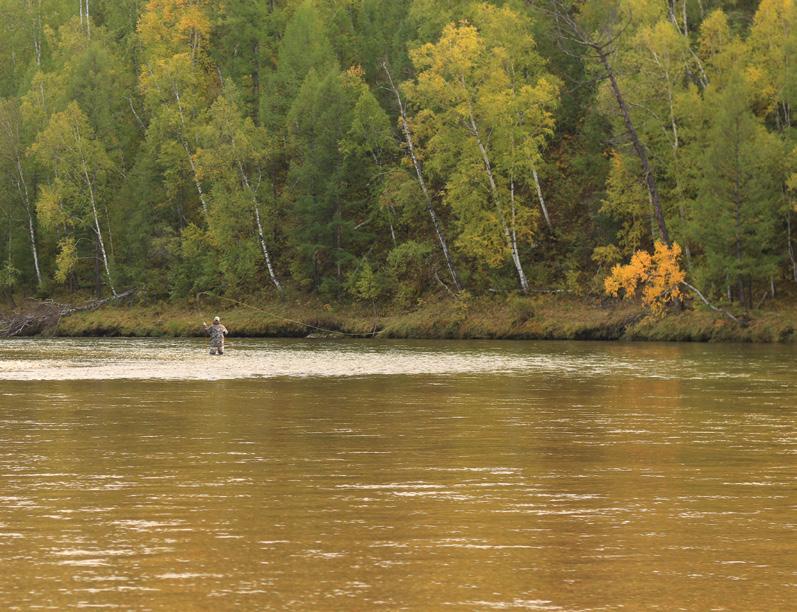
“AFTER I ANCHORED IN THE SHALLOW GRAVEL AT THE BOTTOM OF THE RUN AND CUT THE OUTBOARD, THE SILENCE AND SOLITUDE ROARED AROUND ME.”
and reels to me one at a time, he did so as if introducing me to a friend, with pride and humility and not a sliver of pomposity. Finally, he handed the smallest of his collection to me. It was brand new, the cork still pale and dusty. He had written “Eg-Ur Lenok” on it. It was purpose-built for this river. For this trip. To catch lenok (Asiatic or Manchurian trout). I think that is pretty macho.
I admitted to Brent that I was embarrassed to say that I’d never cast a bamboo rod before so, while I could absolutely appreciate the craftsmanship that had gone into making such a stunning rod, I was unenlightened as to its casting attributes. I was not fishing for a shot, just making an apology for being uneducated. But it came
out as jarring, as if I’d begged and tugged on his sleeve like a child. Being a more graceful person than I, Brent suggested I take it for a fish if I had an afternoon off. He might as well have offered me his daughter’s hand.
As luck would have it, I did have an afternoon off that week. I was dead keen to give the rod a go, but reservations had begun to creep in. First of all, the rod was brand new, hot off the press, a virgin. I couldn’t catch the first fish on Brent’s brand new custom-made Lenok Eg-Ur rod! That’s insane! Imagine spending all those hours planing and sanding and wrapping and tapering and machining and varnishing and dreaming of using it to catch a lenok in Mongolia, only to then hand it over to some scraggly unsophisticated fishing guide whom you’ve known for but a few hours. But that is the type of man Brent is. He was as adamant as he was selfless. “But what if I break it, Brent? What if I double-haul it and that bugger just snaps? I won’t be able to live with myself. I’ll have to harakiri myself right then and there.” He just smiled and assured me that cane was much stronger in many ways than graphite, and it would be very unlikely that I would break it. “Besides,” he said, “I can always make a new tip.” Again. Macho.
Once the wakes from departing guests’ boats had settled and I could no longer hear the slowly fading sound of outboards, I headed out. The jet boat jumped and bucked beneath me, abnormally light without the usual weight of guests as ballast. There had been a lovely cut bank a few bends upriver I had noticed on my morning runs. I’d been saving it for one of those last stop day-savers you sometimes need as a taimen guide. It was on the left bank of the wide river, and the current flowed slowly and almost thickly around pot plant-sized boulders. Large tamarack trees, yellowing with autumn, lined the banks. After I’d anchored in the shallow gravel at the bottom of the run and cut the outboard, the silence and solitude roared around me.
I tied on a Para-RAB, stripped some line off the reel and gave it the ol’ 10-2. The first cast was short and awful. The rod felt tip-heavy and noodly and wobbly. Hmmm. Longer cast. Tailing loop. Shit. I felt that hot flush of disappointment creeping up my neck. This is a Stradivarius, why does it suck? Another cast. Tailed. I felt like I was not going to have a fun day on the water. I’m not sure how many shitty, tailing, looped, wobbly casts I did. It wasn’t theatrical or anything, perhaps just enough to think, “OK well bamboo isn’t really my thing and that’s fine, let’s just try catch some fish and figure out how to face Brent later.” Soon afterwards a lenok rose. It was one of those sexy, not-a-care-in-the-world, lazy, slurpy rises. It was such a nice rise that I sort of forgot about the rod and really started concentrating. I managed an OK cast and this lenok, like most, was as obliging and sucked the fly in with his odd grayling-like mouth and I struck. That was when I fell in
“THE WAY THE ROD BOWED AND I COULD FEEL THE THROB OF THE LINE IN THE CORK. EVERY BEAT OF THE FISH’S TAIL WAS RIGHT IN THE PALM OF MY HAND.”

love with bamboo, in that split second of that set. The way the rod bowed and I could feel the throb of the line in the cork. Every beat of the fish’s tail was right in the palm of my hand.
Many more accomplished writers have said many more beautiful things about bamboo rods, so I won’t gush over it. Suffice to say everything fell into place and I understood it all and Brent had given me the magnificent gift of appreciating the anomaly of bamboo. It’s heavier and slow, and noodly and it warps and costs a fortune and, to the uninitiated, seems pretty pretentious. But once you get used to the casting, and catch a fish with it, it all makes sense, like that Land Rover guy who loves it when his Series 1 breaks down. It is the perfect marriage of form and function. It looks elegant and feels… well it feels

everything. Perhaps I am still undecided as to whether I’d want to catch a really big fish on bamboo. That’s something I will hopefully get to try one day but, if this experience taught me anything, at the very least I understand why someone would want to.
It turned out to be a helluva session too. The fish weren’t big but they were obliging. If you don’t know much about lenok, please look them up. They’re wonderful. The casting came right once I relaxed and slowed down and by the end of the afternoon, I felt that happy harmony of rhythm and timing and balance and got to watch it all come from this perplexing wand.
That evening, I returned the rod to Brent and told him about my wonderful day, and how much I had enjoyed
the rod, but I didn’t really know how to articulate it well enough to do it justice. I could feel a constipation of words as I tried to convey how much of a revelation fishing with bamboo had been. He must have guessed or seen something because, at the end of the week, he pulled me aside and gave it to me.
* I actually really love lazy, limp, fetid, chalk-streamed, pellet-fed, dry fly-sipping, pinky-sticking-out-from-thefine-china cup, soft-ass trout and would love to fish a chalk stream one day – with my cane rod…
For more on Brent Nickerson check out Fred Davis’s blog about him, “Testing the Traditional” at themissionflymag.com or visit his website at eotrfish. blogspot.com

THE OFFICE
INVITED TO VISIT “WILDFLY COUNTRY” (AKA THE MOOI RIVER AREA AROUND NOTTINGHAM ROAD), TUDOR CARADOC-DAVIES GOES TO KWAZULU-NATAL IN SEARCH OF UNFINISHED BUSINESS WITH BROWNS.
Photos. Marius Vermaak, Rhuan Human, Avaran van Niekerk KZN

Picture one of those cinematic high speed life rewind things (with the music playing in reverse like a Chemical Brothers track circa 2000). Instead of taking me all the way from being middle-aged back to getting slapped on the ass as I was born, this pastiche follows the last 10 years, specifically the last time I visited the trout hub of Nottingham Road, in the Midlands of South Africa’s KwaZulu-Natal province.
Back in 2015 it was my first visit to the area. I’d set up a fishing trip with my friend Greg and some other mates. At the same time, a girl I used to work with called Ingrid, suggested she join the fishing trip and drive down from Johannesburg. I may have suggested this plan - it’s a disputed memory. Whatever the case, I was totally up for it. Ingrid met up with me in Ballito and sparks flew. We went through ahead of the rest of the crew to Nottingham Road, stayed at Rawdon’s Country Hotel and, basically, decided we were going to spend the rest of our lives together. The guys then joined the fishing trip and while I left Ingrid on the banks of the Mooi River with Greg’s beagle, Henry, Ingrid uttered two immortal phrases, both lies, that became lore and even featured in our wedding speeches a couple of years later. “You look sexy in waders” and “I love dogs”, the latter as Henry raced off after random critters in the bushes while Ingrid (a cat person) stressed that she would lose this incredibly strong-willed bastard hound. Other than landing her, I blanked badly that trip.
Fast forward - a wedding, this magazine, homes moved, babies now toddlers, places fished and rendezvous missed. A few weeks ago, a chance presented itself when the WildFly crew invited me to fish in the KwaZulu-Natal Midlands again and on the Mooi River around Nottingham Road specifically. I asked if I could include a plus one. Ballito-based Greg had plus minus three to five weeks to go before his girlfriend was set to give birth so, with his world about to change and the likelihood of any fishing in his future being slim, he was in.
Greg and I go way back. We were introduced by one of my exes and in the split I got to keep Greg. Back then Greg, a Durbanite, lived in Cape Town where he was the most Capetonian hipster you ever could meet. He worked as a graphic designer and photographer and referred to his office (literally a desk, chair and Macbook) as his “studio”. We were both members of an informal eight-person music sharing club where Greg favoured music by banjo-plucking hill people who wail like ghosts in severe distress. He wore a woollen beanie and smoked rollies long before anyone else (merchant sailors aside) and he had a film camera he actually used. About the only non-hipster thing Greg did was play in the same weekly game of touch rugby I did and endlessly talk about the sport with me. Then, Greg moved back to his hometown Durban and got into film and advertising production. He cringes when I bring it up, but (along with some other stellar work), Greg directed
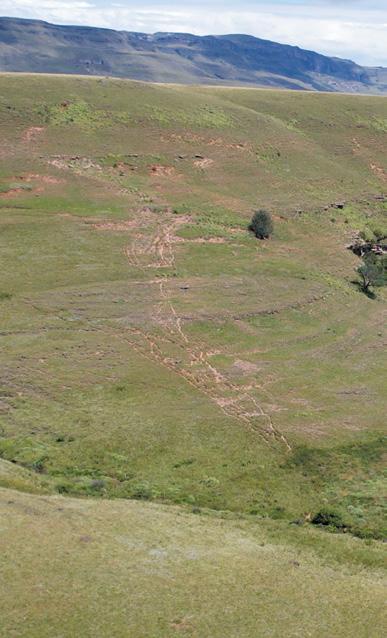
“THESE UPPER REACHES OF THE MOOI, WHERE THE ESCARPMENT GIVES WAY TO STEEP HILLS AND JAGGED KLOOFS, ARE STUNNING. IT’S THE POSTCARD DREAM APPEAL OF THE REGION.”
the phenomenal Chasing the Sun series following the Springboks’ World Cup successes in 2019 and 2023.
The guy silhouetted off-camera asking questions that made Rassie cry? That’s Greg.
Head Office
Did you know that in rugby, when test level front row forwards are scrumming against each other, the pressure on their necks and vocal chords is so intense that they cannot talk? Loose forwards and locks can still throw the odd chirp or roar of encouragement (PRESSURE IN THE REAR MANNE! P@&S HULLE BAKKIES!), but not the props and hookers. Except for Springok loosehead Ox Nche that is. Ox is different, as evidenced by the way he scrummed the English pack into reverse gear in the World Cup semi-final in 2023. And, apparently, as he touch-pause-engaged with English tight-head Kyle Sinckler, Ox in that unmistakable soft, almost-sweet tone of his, told Kyle exactly what was about to happen to him.

After arriving on the Tuesday afternoon, Greg was recounting this tasty outtake as we shot out of Nottingham Road in WildFly head honcho Gareth George’s LandCruiser to try to grab a quick hour and a half session on the Mooi before we lost the light. The Ox anecdote Greg was telling us (to be clear he was quizzed and was responding), was regrettably one that did not make it into the final cut of Chasing the Sun 2 . Gareth had similar anecdotes as WildFly has produced numerous TV shows over the years with global audiences. In one awkward encounter, which I think may never have aired, he had Bobby Skinstad interview Gary Teichmann (this after Teichmann had been deposed as Springbok captain by Skinstad). Teichmann, made his loot in civils engineering contracting post-rugby and, with it, he bought a farm in the Midlands. That’s where we were about to fish, one of many properties along the Mooi River (and others containing trophy fish farm dams) for which WildFly has the connections and the gate key codes.
Armed with TFO 4-weights we made our way along a copse of poplars and began to fish upstream off the banks of the Mooi as crepuscular browns, greys and charcoals smudged the landscape towards night. Coming from a Cape streams background where we spend a fair amount of time getting into rivers in order to fish upstream unhindered, I wasn’t used to this bank approach. Struggling to A) keep my line out of the blackjacks and brambles at my feet, B) my backcast out of the trees and C) my fly from dragging across several currents, I ignored protocol and got into the river. Waders aren’t recommended around here due to all the barbwire fence-hopping you do, so it was cold but, being positionally comfortable made a difference. Fishing a few short runs and some larger pocket water, my elk hair caddis disappeared in the gloaming and a pretty Mooi River brown came to hand. Losing the light, before heading back to town, we were joined by the farm manager for a couple of heart-warming tailgate whiskies and more insider stories about fishing, TV and sportsball.


PR & HR
Our host for the morning of the second day was Rhuan Human, Gareth’s consigliere and the actual host of another WildFly TV show, My Visserman Vriend. He’s also, according to Gareth, played a significant role in turning WildFly on to the Afrikaans fly fishing market, arguably the fastest growing segment in the South African scene. Rhuan and his producer, Avaran van Niekerk, wanted to take us quite a bit further upstream on the Mooi, out of the farmland and into the kloofs, to the kind of dry fly country Tom Sutcliffe wrote about. It’s also a spot so stunning that Avaran wants to bring his cherry there for picnics and canoodling. Winding through farms, we stopped to dip our wading boots in a trough to sanitize against foot and mouth lurgies, while an Anatolian sheep dog swore at us through a fence in Turkish.
This part of the country has recently been smashed by rains that could not simply be described as ‘unseasonal’ but ‘unprecedented’, breaking records (the wettest March since 1968), messing up farming approaches and, hopefully, silencing any lingering climate change denialists. As a result, most of the river season had been unfishable. Our visit was squeezed in right before the season closed, but you could tell that conditions were not normal from the uncertainty around whether the browns would be there in numbers or if most of them had gone upstream to spawn.
We parked on the summit plains, kept an eye out for the herds of wild eland Rhuan says roam the mountains, took a squizz at the Kamberg mountains in the distance and rigged up. As we made our way down to the river, flushing reedbuck from their grazing on the slopes, a large, disputed (Lammergeier! Black Eagle! Cape vulture!) bird of prey circled overhead.
The morning began well. Rigged up with dry-droppers and after Greg fished a few runs, I had a go. At the beginning of my first run a good-sized fish hit the dry, the four of us began a synchronised whoop like chorally-trained chimps and seconds later it came off. A few more casts and another 10 metres up the run, a second similar-sized fish hit the Zak nymph and this too came off. Somewhat nonplussed, but optimistic, we continued up river expecting plenty of action, only to mysteriously blank for the rest of the morning. Cast after cast went out over perfect looking water yet nothing happened much, to our collective confoundment. We didn’t see a fish for hours, except for in the tail of one pool where we spooked an absolute moose of a fish and its medium-sized friend. Just before returning
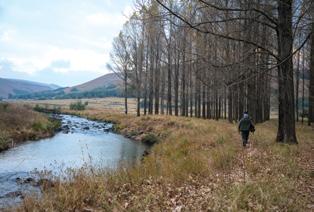
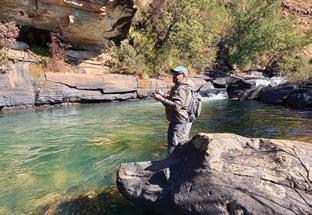
to the car, at least an hour and half later, I made my way back to that run to get a second shot. Taking an extremely wide route, far back from the river’s banks, I thought I’d ninja-ed my way into giving myself the best possible shot at that fish, only for it to appear looking spooked again and then disappear under a rock shelf.
Despite blanking on the score card, it was a special way to spend a morning. It’s not that the Mooi is unattractive where it runs through the lower stretches, it’s more that in these upper reaches, where the escarpment gives way to steep hills and jagged kloofs, the river is stunning. It’s the sales pitch, the stuff PR is built on, the postcard dream appeal of the region. And while we fished another afternoon session with Gareth on another stretch of the Teichmann property and where I caught a small brown on a CDC parachute thing, my mind was still on the morning’s fishless session upriver.
“THE BIGGER BROWNS NEED SOMETHING TO ENTICE THEM OUT OF THEIR LIES. SOMETHING HEAVY AND SHINY TO HEADBUTT.”
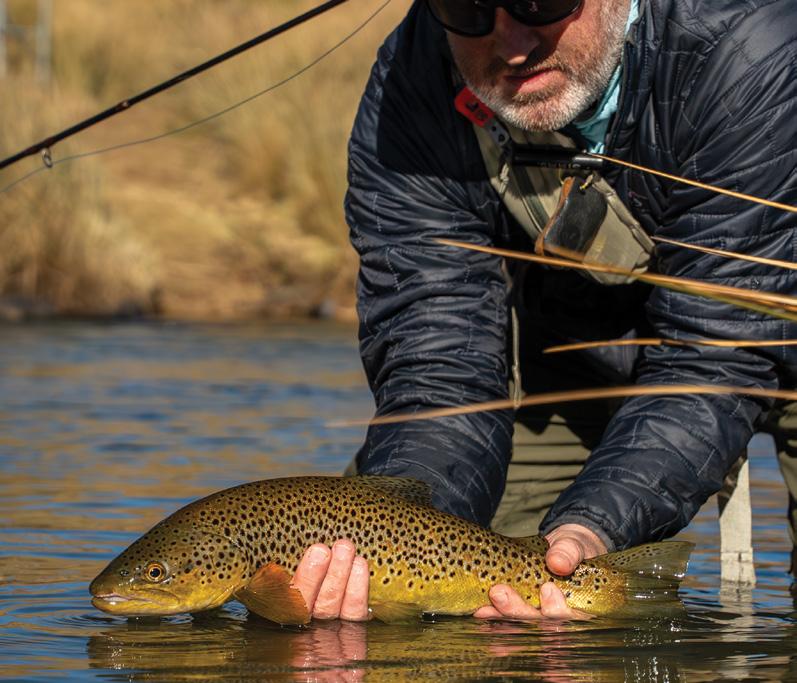
Accounts
On our first afternoon, Gareth asked, almost furtively, as if fly fishing purist police might rappel from the poplars if overheard, if we were open to “guerilla tactics”. It turned out that that meant swinging streamers to the undercut banks and other structure to provoke the bigger browns into chowing. Being a hipster, Greg is a little more of a traditionalist (he’d probably use a typewriter in place of a computer and a carrier pigeon in place of a phone if he could) so I could tell this wasn’t going to be his thing. While I love a dry fly eat as much as the next guy, I have no such qualms, especially when the fishing is tough and the chances of being able to tell a story (one that has some fish in it) hangs in the balance. Having been on enough shoots themselves, the WildFly guys understand this too, so with our scorecard showing only a few small to medium sized
fish on the dry or dropper, Gareth roped in the ultimate weapon, Grevin Price, to take us out on Thursday, our third and final day.
If we were playing in WildFly’s “office”, I came to think of Grevin as “The Accountant” (in the soft spoken Ben Affleck killer sense). He knows what the bottom line is (catching fish) and can always balance the books. A softspoken sheep farmer, you won’t hear Grevin boast about his exploits but, if you pay attention to the walls of the Nottingham Road Hotel pub where his name is all over the competition honour rolls, or if you listen to anyone’s conversations pertaining to trout, Grevin comes up all the time. He does not refer to what he does as guerilla tactics, but plain old “catching fish”. And it’s not like Grevin’s some hard-nosed streamer fanatic who dreams about



being reincarnated as a steelhead junkie in another life. For him it’s simply common sense. He does fish dry flies when there’s a hatch on, but he knows the Mooi and its browns backwards and to get bigger fish at this time of year it’s unlikely to happen drifting dries.
Grevin took us to a section of the river with small fast rapids and deep chutes running into deep glides and pools dotted with large boulders. Perfect brown trout ambush territory. Aggressive and territorial, but unlikely to get out of bed for anything below their pay grade, he explained that the bigger browns need something to entice them out of their lies. Something heavy and shiny to headbutt. What you want to do Grevin said, is to rig up with an intermediate line (floating will do), a shortish leader and an orange, tungsten-beadhead, black wooly
bugger style streamer with marabou or zonker and a little flash, like a Spiedkop. Cast that out, wait a second or two for it to sink and straighten and then a short sharp jerky retrieve alternating with longer strokes should result in takes. Suitably briefed and in position, on my second cast my Spiedkop got slammed. The 4-weight bucked and bent as the fish set off. A few minutes later, Grevin netted my first proper Mooi River brown. We fished on for a couple of hours with no further takes and just as we were about to pack it in, in a turbulent triangular pool with just a surfboard-sized patch of calm water before a large rock that looked like it could offer enough cover to hide a fish, another similar-sized brown came up, seemingly out of nowhere, to give the fly a Liverpool kiss. My morning, day and trip made, it didn’t matter that the afternoon session in another area was a bust - Grevin had delivered.

Phuza Thursday
Part of the planning behind this visit was for me to overlap with the opening night of one of WildFly’s Tops Corporate Challenge weekends. Don’t be put off by the ‘corporate’ bit. These long-running, incredibly popular events held over four weekends in winter (the fourth being a final from the previous three) sees companies enter teams of four to fish the various stillwaters WildFly has access to. The prep had been building visibly for days (no doubt weeks unseen) as Gareth, his wife Genna who runs the events and the rest of their team worked on set-up, from branding to goodie bags, prizes, packed lunches and accommodation at the hotel. That Thursday night, river-tired and sunbaked, Greg and I joined the event’s opening dinner. As we’d rolled into the parking lot earlier, cars from Joburg and Durban were pumping tunes as guys unpacked and
got stuck into welcome drinks. There was an electric office party air as everyone loosened up from their office personas and engaged jol mode. Over dinner, as the Notties Hotel pizza ladies slung pies around the room, Gareth did his MC thing expertly, fining and shutting down chirping hecklers, while keeping the pace and the gees high. Briefing the troops (made up of both grizzled angling veterans and plenty of complete noobs too) on how the event works, he allocated teams their dams for the next day and generally set the tone for people to let their hair down and have a bloody good weekend away with colleagues and clients.
As everyone shifted over to the pub, the volume increased as the crowd got more lubricated. There’s a line of dented brass heavy pots on the ceiling of the Notties Hotel pub, which custom has it, one must jump and try to connect

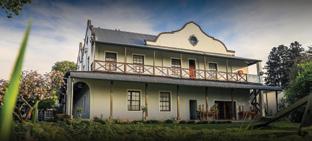

WHEN IN NOTTINGHAM ROAD
SHOP - WildFly
Forgot a rod or reel? Need a line or a fine float tube? Looking for inside info or water access? WildFly’s existing fly shop on the Notties main drag has you covered and in a couple of months their new triplestory shop will take over the reins. wildfly.co.za
STAY - The Nottingham Road Hotel.
Comfortable rooms, great pub grub and restaurant fare, plus it’s where the townfolk are likely to be found if you are looking for extra intel on fishing, friends, fornication etc. nottieshotel.co.za
EAT - The Bierfassl
While most of your meals should happen at the Notties pub, make sure you go to The Bierfassl for at least one dinner featuring their famous eisbein, sausages or schnitzel and copious amounts of German and local craft beers. bierfassl.co.za
Blue Ribbon 4-weight rod. tforods.com, wildfly.co.za

- 444 Series Modern Trout line. cortlandline.com, wildfly.co.za
with, with your head and this soon became the focal point of the packed pub’s energy. As a fellow middle-aged city slicker, I could totally see the appeal of coming out from your Groundhog Day winter hibernation at home; to get out, get revved up and headbutt something shiny and heavy.
As Gareth and the team cranked out Ard Matthews’ Leaving Shallow Waters at 5am the next morning to eject the Corporate Challenge crowds from their beds and into waders and float tubes, Greg and I packed the car and set off for Durban. While I’d finally got the Mooi monkey off my back, he’d blanked this time, but with an incoming baby on his mind Greg didn’t look too fussed. As it was, the director and the accountant had hit it off and were hatching big plans for future fishing.
SHOP THE MISSION
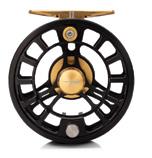
- NTR Fly 3/4 reel. tforods.com wildfly.co.za


Patagonia - Forra Wading Boots. patagonia.com
Patagonia - Stealth Switch Pack - 9L. patagonia.com
WildFly’s mobile shop for events.
The Notties Hotel.

THE MAGIC JUNGLE
WHEN NOT DODGING FLATDOGS AND THROWING FLIES AT NILE PERCH ON LAKE TURKANA OR THE MURCHISON NILE, ANDREW NIGHTINGALE LIKES TO RETREAT TO THE MATTHEWS MOUNTAINS OF NORTHERN KENYA WHERE DRY SAND GIVES WAY TO A WEALTH OF WATER AND WAITING FISH AROUND EVERY BEND.
Photos. Andrew and Patrick Nightingale
KENYA
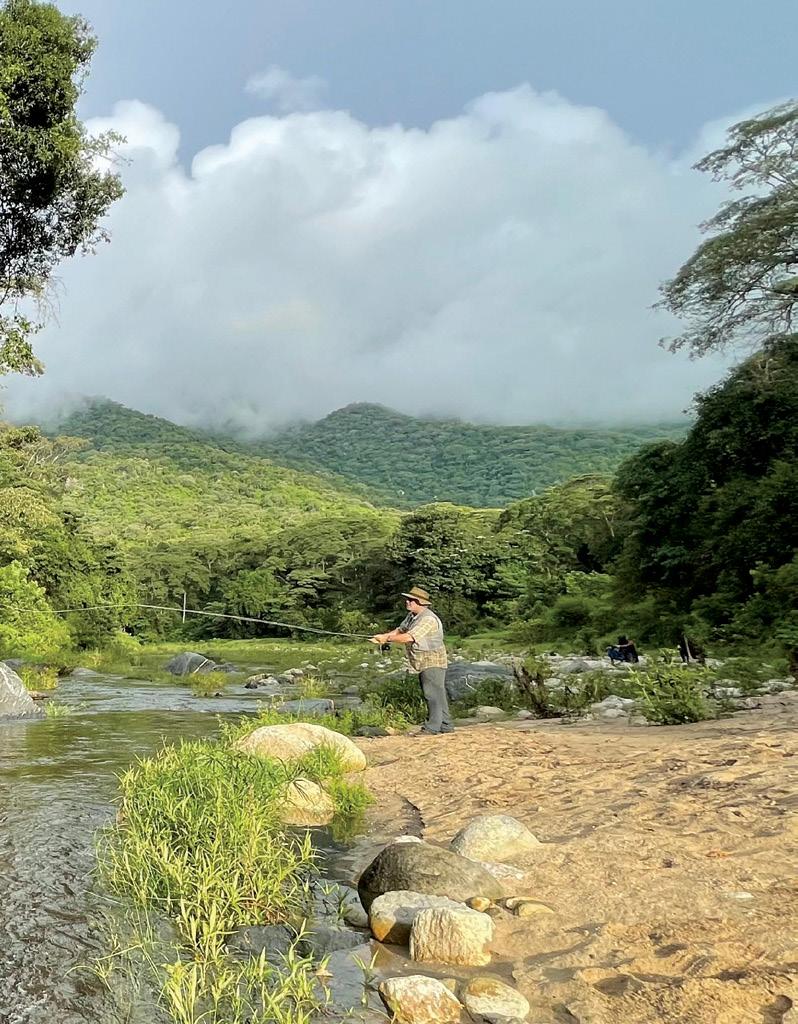
The trusty old Land Cruiser roars in protest as I change down gear to descend into yet another gorge, ensuring I’ve got suitable torque to deal with the sand river crossing I know waits at the bottom. Luckily this one’s flowed recently and the sand is nice and compact, giving our wheels only a slight spin as we angle up to climb out the other side. We smell elephant in the thick bush around us, but the only visible sign of these magnificent animals is the plentiful poo and their huge prints that adorn the rough track ahead.
Samburu country in northern Kenya is an ochre-red, sunscorched land of acacia thorn and seasonal sand rivers, interspersed with magnificent ranges of lush granite hills and mountains.
The Samburu who call this place home are pastoralists, a people suffering from the consequences of too much of a good thing – the benefits of tsetse fly eradication and access to modern veterinary care. The resulting booms of cattle and goat populations leading to overgrazing and habitat destruction are all too obvious. The Samburu have become increasingly aware of their role in the conservation of this amazing environment. Through the Northern Rangelands Trust they have set up a host of Community Conservancies that create recognition of their ownership of, and give authority in, their stewardship of these vast wilderness areas. Kitich Forest Camp has an exclusive lease from the Ngelai Conservancy Trust in the Kitich Valley. Their boutique tented lodge is nestled between monumental granite ridges of the Matthews Mountains – an island of green in the African sky, towering above the dry bush country of northern Kenya.
I love the magic of sand rivers, long twisting sandy beaches fringed with flat topped acacias, tamarinds and the occasional doum palm. They may seem dry, but their beauty lies in that their water flows underground through the sand, occasionally surfacing when forced up and over some rocky barrier. When the big rains do come, furious floodwaters flush everything downstream. Juvenile fish who haven’t learned to cling to safe back eddies are washed away and end up downstream, stranded in pools under overhanging cliffs or on the edges of floodplains and swamps. Most are appreciated by opportunistic predators, but some survive, often waiting for months for the next flood, and the opportunity to race back upstream in search of clearer waters.
Elephants love sand rivers. The seasonal floods wash down huge varieties of seed which take root in the wellwatered sand, providing tender, fresh browsing. Clean, pure sand-filtered water is there, deep under the surface, and the elephants dig wells that provide water to a whole plethora of wildlife. Pastoralists and their livestock often follow fresh elephant trails, secure in the knowledge that these ancient pachyderms always know where to find the sweetest water.

A stand of gnarled old acacia trees mark the almost invisible turning north into the Kitich Valley. A crawler gear lowers us down the steep sandy bank, and we ford the Ngeng River flowing eight inches deep here – it disappears underground a few kilometres downstream. A cloud of electric blue Papilio and copper coloured Charaxes butterflies explode off the trail as we ease our way off the map and into a perfect paradise.
My brother Pat and I need a bit of time together, away from the humdrum of our “normal” lives. Pat used to guide walking safaris through the Okavango and various destinations in Kenya. An escape for us must be off the beaten path, away from the rat race and into somewhere quiet and serene; a place to pretend, for a little while, that the other world out there doesn’t exist. Our time together is limited, we have to choose somewhere really exceptional to spend these precious instances. I decided to bring him up here, to the Kitich Valley, a tiny place he

hadn’t seen yet. We both enjoy spells together, without the need of much verbal communication, just basking in moments shared in mutual appreciation of somewhere special. Conversations can happen later by a roaring campfire, beer in hand. Now is time to enjoy the distilled simplicity of nature, an oxymoron of note in such a beautifully diverse and pristine ecosystem.
As we enter the valley, the vegetation changes visibly from dry thorn to lush forest. Protected from harsh desert winds by the soaring Precambrian ridges either side, cedars, podos, crotons, figs and a host of other forest trees thrive in this moisture trap. Giant cycads abound here; an angiosperm – a non-flowering early lineage of plants whose seeds form before being fertilised by a specific species of beetle. No pesticides up here to destroy a delicate symbiosis. The valley is home to the rare De Brazza’s monkey and a whole host of other forestdwelling creatures. Truly an unspoiled Garden of Eden.
“THERE’S NO DESPERATION TO CATCH YOUR FISH, THEY ARE JUST THERE. THERE’S NO SENSE OR PRESSURE TO RUSH.”
Rateno Leloolgiro, an elder of the community and a guide has worked at Kitich for ever. With great excitement he told me he was now into fly fishing and showed off his recently acquired 7’8” broketip. I had been asked by lodge management if I could spend some time coaching this self-appointed ghillie with his sawn-off fly rod and ancient crinkly fly line. I remembered being out-cast by a guy in the States who used a broomstick with an eyehook screwed into the end of it to demonstrate the fact that we needed to work on ourselves before we blew money on ever more expensive gear. A good lesson – learn with what you’ve got.
There was still an hour and a half of daylight left, so rather than unpack and settle in, we voted to get straight out onto the river. Under our guide’s studious eye, we rigged up our fly lines. I replaced Rateno’s crinkly mono with a tapered leader, demonstrating a nail knot then a Lefty’s


loop knot to attach the bead-head prince’s nymph that he’d chosen. We were ready. A herd of buffalo had recently flattened a trail through the lush grass as they had tramped upstream. In this time of impending darkness, we astutely opted to fish downstream.
Pat wandered off down the bank and after a few casts forgot to fish as more and more birds caught his eye. The birding here is superb. Malachite kingfishers flit through the riverine overhangs while giant kingfishers patrol up and down the river, their harsh squawks countered by the ethereal cries of circling fish eagles. A noisy group of puffbacks have found something in the treetops to get angry about – an owl maybe?
Rateno was looking frustrated with his self-taught wide open S casts, so I spend a bit of time with him, breaking down the physics into little sequences of understanding.
Rateno Leloolgiro

“WE MAY BE LOOKING AT A SUBSPECIES OR EVEN A NEW SPECIES AS THEIR PHYSICAL SEPARATION FROM ALL OTHER POPULATIONS IS QUITE EXTREME.”
In no time the magic of a D cast and a simple lift-and-drop steeple cast changed his whole world. Practise, practise. I know I’ll be back after a few months and can help take his skillset a little further.
I wander down to the next pool where I spy dark shadows on patrol under the overhanging umbrella sedges on the opposite bank. An easy side cast neatly drops the black ant fly onto a drift down where it is gently slurped into a firm hookup. A beautiful eight-inch golden Labeobarbus is beached and released. I repeat the process along the river, enjoying the predictability of an easy run as I enter my happy place. This is the therapy I came for.
The magic of Kitich gently engulfs me. There’s no desperation to catch your fish, they are just there. There’s no sense or pressure to rush, to be rough on the fish. One can delight in being soft, being at peace, taking one’s time as all sense of urgency melts away.
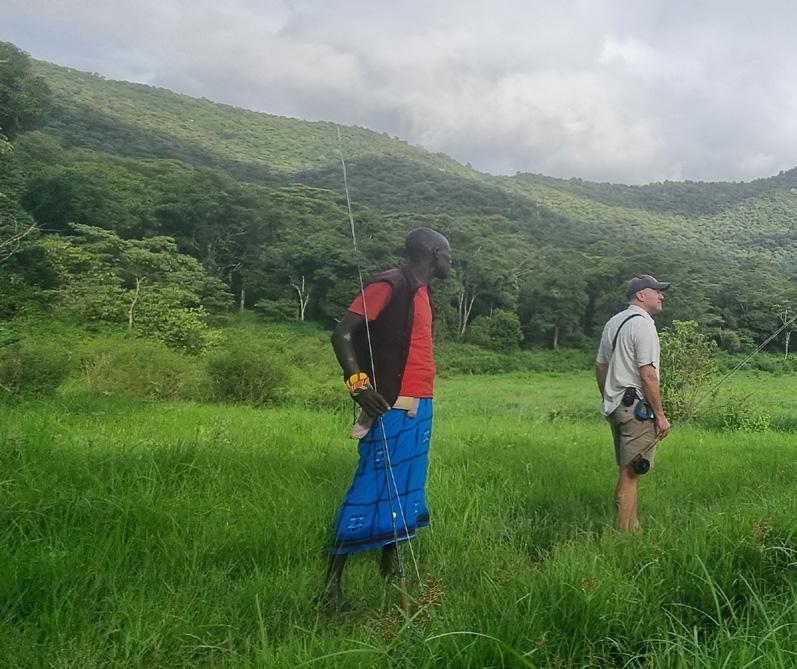




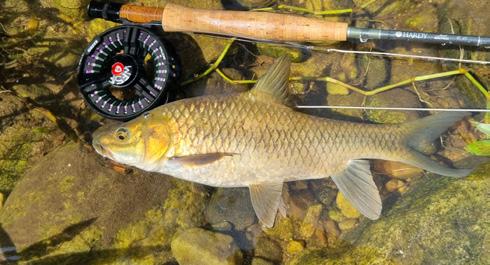
As darkness fell, we meandered back to camp, to be greeted with a roaring campfire. Rateno tells us that the fish in this valley have been left alone by the Samburu who, being pastoralists, don’t eat them. That is why this place is so special. He wants to know more about fly fishing and improving his role as a ghillie. We discuss upstream tactics and client courtesies. I marvel at his encyclopaedic knowledge of this home area, but am able add to his already prolific knowledge of the bug life here, pointing out connections between the aquatic nymphs and their terrestrial adults.
The campfire crackles away, the stars shine, and over a series of chilled tinnies we put the world to rights.
Dawn breaks, crisp and clean. Blue skies herald a hot day coming, a stark contrast to the mist-shrouded trees in the valley where I cup my hands round hot, fresh coffee, savouring the dawn chorus that echoes through the forest.


As the sun comes up, we meander up the river in a dreamlike state of bliss, scintillating silvery dewdrops hang on every blade of grass and leaf. Dragons and damsels decorate the banks with their jewel-like flashes of colour. I’m about to select an appropriate nymph when an emerald grasshopper leaps away and is grabbed the instant it touches the stream. Spoiled for choice…
It’s one of those mythical textbook days. Every boulder and riffle I’d expect to find a fish in, I’m rewarded with a little more gold. I feel like a fine creeksmith.
A thermal passes through the valley and ruffles the trees in its path, a few beetles plop into a dark pool. There’s a race of aurian bodies and the terrestrials are slurped off the surface, the fish were expecting them. I change over to a black foam beetle hoping for something larger in this deep protected pool. The fly line uncurls under the overhanging branches and the fly drops into the shadows to an instantly solid strike. A much better fish.
Andrew Nightingale
“WE LUNCHED ON PLOUGHMAN’S AND NAARTJIES BY SOME GIANT CYCADS. I MARVELLED AT THESE GNARLY OLD JURASSIC GIANTS WHO’VE STOOD GUARD OVER THIS VALLEY, UNDISTURBED FOR CENTURIES.”
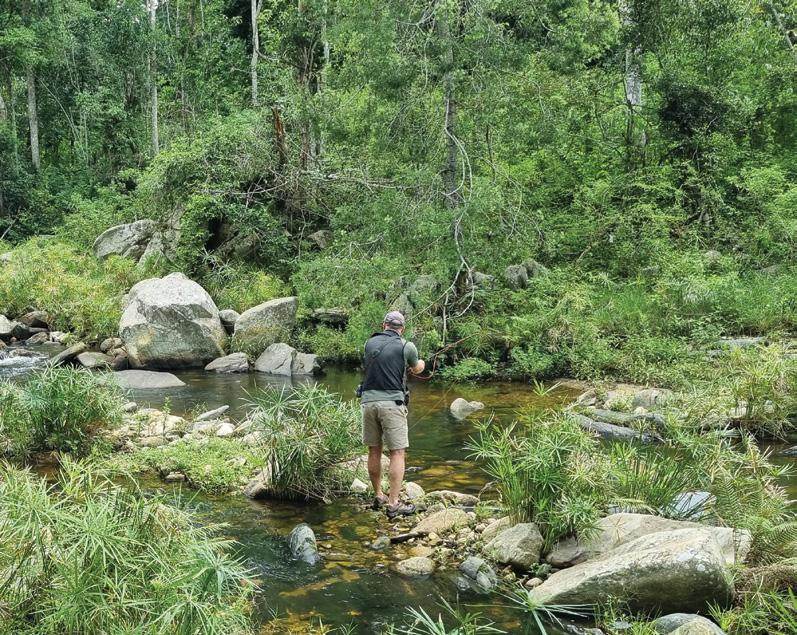
I leapfrog past Rateno, content with the fly fishing bug we all know so well. He has gone into stealth mode and switched his bright red shukka (blanket) for a green one and is now stalking fish in each rapid and riffle.
Pat is also content; he’s caught enough yellows that he’s stopped counting. The podo tree above him is in full fruit and he is watching a gang of Hartlaub’s turacos bicker and cavort around the treetops. We have a coffee and snack together and bask in the beauty of this place. A pair of bushbuck tentatively tiptoe out into the open and cross the river upstream before melting into the shadows of the opposite bank.
So what species of yellowfish are we catching here? I am not convinced that we are even close to comprehensively identifying our cyprinids here in Kenya. Various “experts” have authoritatively named this Labeobarbus as three different species. Something’s wrong somewhere.
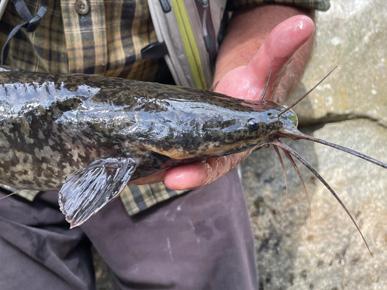

Maybe for sake of argument just call it the Matthews Barb for now. The Ngeng River disappears underground a few kilometres after leaving the Matthews Range and its resulting sand river joins one of Kenya’s largest sand rivers, the Milgis. From where the Ngeng seeps underground, there are over four hundred kilometres of sand river before it joins anything like a permanent river in the form of the Northern Ewaso Ng’iro drainage. We may be looking at a sub-species or even a new species as their physical separation from all other populations is quite extreme. Until we get a bit more of a head start on MDNA sequencing we are not going to have clear answers. Too deep a train of thought for today’s mission.
Moving on upstream ahead of the others, I pass otter scats crisp with the undigested remains of freshwater crabs. I reach a deep pool where the river has undercut a twenty foot cliff. There are signs of a recent collapse, but the dark depths look promising. The damsel nymph picks up a few eight-inch beauties but is being grabbed by the smaller fish. Maybe a bigger fly? I pull out the box and see the largest hook I have in there today is a Pombe Queen – a variant of a Mrs Simpson. Well, let’s see if the sovereign of this pool is willing to give up his kingdom for Mrs Simpson’s barroom buddy.
I cast out over what looked like the deepest section of the pool, gave the line a count of ten to sink, then started a tadpole-like slow retrieve. Nothing – maybe not deep enough. I reset the line and doubled the time for the line to sink and began the retrieve again. I must be close to the bottom as I felt the line gently brush over some resistance – probably soft sediment. And then boom! A solid take, from something that had no intention of coming up. A run up to the head of the pool, then back down deep. Holding the rod high I tried to keep the line free of snags and bring this beast up to the surface. I had no option to reposition unless I was forced to swim. I chucked my day pack, jacket and tackle belt up onto the bank ready to get wet. Eventually the fish agreed to capitulate and I walked it gently backwards into the tailwater’s boulder-field, hoping to persuade it into a shallow pool where I could beach it. Keeping low and out of sight I was surprised to see a speckled treat come out of the depths – a stunningly marbled sharptooth catfish, a unicorn among fighters. Such colourations in this highly variable species are rare and are usually only found in the clearest of rivers. Well, that checks out for this place.
Pat turns up and we photograph this beauty before letting him slip back down into his shady realm. We backtrack
and use an elephant path to navigate up to the next section of river, a boulder-strewn fern-filled maze of pools and channels teeming with little Labeos (moggels). It seems every rock has two or three clinging on. We’d seen them downstream but not in these numbers. Nothing we drifted past them elicits any response. Were they up there to breed? It was like they were resting, waiting for something.
We carried on upstream till we came across a series of dark polished basalt intrusions, so different from the lighter granite boulders we had been fishing between earlier. A barricaded series of cascades and shoots where more recent fault lines had offset the softer rock. One fault line piqued my interest where a narrow crevasse had formed a wonderfully deep, slow-flowing channel. Now if I was a monster, I could monitor any titbits passing through here.
Pat arrived and I showed him the potential I saw, he crept into position and lined a perfect cast up the channel, taking in the loose line as his fly drifted down. A flash of deep copper and he was on. With nowhere to go, this beauty could only run laps up and down the crease, was tired to submission and the yellowfish was led into a shallow outflow to be revived and released. Textbook, beautiful, satisfying. We lunched on ploughman’s and naartjies by some giant cycads. I marvelled at these gnarly Jurassic giants who’ve stood guard over this valley, undisturbed for centuries. Rateno joined us and pointed out the thunder clouds nimbusing over the head of the valley. We could feel the pressure change and the build-up of energy in the air. It was going to get proper wet.
As we wandered back down the Ngeng, I noticed a deep pool between giant boulders that I’d missed on the way up. I couldn’t resist, so worked my way round in a big circle to position myself below the spot. I kept the sinking line on with the trusty Pombe Queen and shot a wonderful cast right up next to the little waterfall that fed the pool. Something went for the fly but I’d gotten too much slack in the line with the waterfalls back eddy and twisting waters. I missed it. I laid the line out again, this time in slacker water and kept in touch with a faster retrieve. The reward was a sudden thunk, and the biggest fish of the day latched on. It took off past me out of the pool and down two more shutes before I got control of the fight and landed a gorgeous twenty-two-inch specimen. Size does matter – I was so chuffed.
The heavens soon opened, and the warm rain soaked us through in seconds. There was no dampening our spirits, the sweat was washed from our bodies as we strode through the refreshing downpour back to camp. No campfire awaited us, but a dry change of clothes, a quick cup of tea followed by a well-deserved ice-cold beer put us in the tranquil mood of perfect peace and harmony with the world.
From the comfort of a well-built, open-plan mess, we were treated to a magnificent sound and light show as thunder

cracked and lightning flashed around the hills. The river soon rose, and we went to bed to the sounds of a raging torrent passing us by. In the morning the river was still high and had turned from crystal clear to a chocolate brown. We derigged and packed the Cruiser, then enjoyed more coffee while we waited for the floodwaters to subside. Within a couple of hours, we deemed the river low enough to skedaddle and started our long drive home.
I’ve always been reticent about publicising special fly fishing spaces, especially if they are smaller, more fragile ecosystems; that by turning the middle of nowhere into somewhere I might have endangered its very existence. Through reading about so many great destinations in The Mission, I realise that by putting value onto a place, one can hopefully create the awareness needed to justify the preservation and conservation of that environment rather than leaving it to fate. We fly fisherfolk could and should be the very reason a special place gets to remain so specia.
Pat Nightingale
WAYNE’S WORLDS
LOW-KEY AND UNASSUMING, YOU’D BE FORGIVEN FOR NOT KNOWING ENOUGH ABOUT WAYNE HASELAU , ONE OF THE SEYCHELLES’ AND SALTWATER FLY FISHING’S GREAT VETERAN GUIDES. TO REMEDY THAT WE FINALLY PINNED HIM DOWN TO CHAT (AMONGST OTHER THINGS) ABOUT MILKFISH, TRIGGERS AND CLIVIAS.
Story. Tudor Caradoc-Davies
Photos. Wayne Haselau, Vaughn Driessel
“Find what you love and let it kill you” is a wellknown line often attributed to Charles Bukowski, although its exact origin is debated. It speaks to the idea of finding one’s passion and dedicating oneself to it wholeheartedly, even if it leads to personal hardship or sacrifice. Wayne Haselau, though very much alive, embodies that ethos more than most.
Old guides are hard to find, especially in the salt where everything, animal, mineral, vegetable, seems to weather and break down faster. Most older guides become managers or find new turf and attempt to start up their own guiding operation. Or, they retire by the ripe old age of 40 and try another way of making a buck, either working in fly fishing shops or in other fields. Wayne is an outlier in this world, having guided for 20 years at the forge of saltwater fly fishing in the Seychelles.
For me, 61-year-old Wayne bears a strong resemblance to Jeff Bridges’s iconic character, the Big Lebowski, aka “The Dude”. He is a super mellow, easy-going guy. That could be because the parasites that control him are, for the most part, pretty chill. All across the natural world you’ll see examples of amazing parasites that control other organisms, essentially making them do their bidding. There are parasitic barnacles that turn male crabs female, parasites that control zombie ants, and parasites like malaria that kill millions of humans. In fact, as hosts, humans are crawling
with the things. It is estimated that the average human body harbours hundreds of parasites. Watch RFK Jr. open his maw on TV and you know his tapeworm is in control. Have children and you’ll find yourself doing ridiculous things just to get them to eat or, in the soothing tones of Samuel L. Jackson, “Go the fuck to sleep.” It’s sometimes a little hard to know where you end and the things you love, and which sometimes control you (parasites, passions, obsessions, emotional drivers, crotch fruit, etc.), begin.
In Wayne’s case, I believe two friendly parasites have been in charge. For the better part of his middle years spent exploring remote Seychelles atolls and islands, the parasite that was in control was the one that made him lust for fly fishing and the challenge of deciphering specific species of fish. More recently, an older parasite has taken over, one centred around clivias. This parasite was with Wayne in his youth in the Transkei and, as he gets older, it tugs on his reins like some hormonal horticultural horse trainer. Yes, clivias… as in the plants. Indigenous to Southern Africa with long dark-green leaves shaped like a Gurkha’s kukri and flowers that range from orange to yellow, you’ve definitely seen them before. In case you did not know it, the clivia world is a SCENE, one with obsessives, as in fly fishing, where varietals are hunted down, plants or bulbs traded, stock bought up by ravenous demand from the Far East and elsewhere, fortunes and reputations made.
Wayne’s lived in both worlds.

Wayne grew up in Cape Town, South Africa and attended the country’s oldest school, SACS (South African College Schools). His father Gary was a pioneering scuba diver and well-known marine camera operator who worked with Jaques Cousteau. Of his father, Wayne says, “He was a player. I was different in the sense that where he was a diver and a hunter, I was a fisher and a surfer, but he understood me. He did end up fishing too, by default, because he got dragged along with me.”
Wayne recalls asking for a fly rod for his sixth birthday and the disappointment when Gary insisted on getting him a bass rod instead. He said, “No, you need to be skilled to use a trout rod, you’re gonna be useless. You can have a bass rod.” On their first outing to test the rod at Clanwilliam Dam, Wayne hooked what his father dismissed as a rock only for the rock to move and eventually reveal itself as the new dam record smallmouth bass at 5lb, 11 oz. Wayne, still the moer in about the bass rod diktat, worked on his mother to make sure his dad got him a fly rod for the next birthday. Suitably equipped, he soon became a regular on the Cape streams like the Smalblaar/Molenaars and Elandspad.

“Those were halcyon days. As I got older, I used to go by myself. I would wear a crappy jersey, with six or seven dry flies hooked into my sleeve. I’d have a tub of Mucilin, a roll of six pound Maxima for a leader, plus my rod, reel, takkies and obviously polarised sunglasses. This was in the days before there was a tunnel running into Du Toit’s Kloof, so we used to do that long mission all the way up and over the top. You’d get to the top and look down into the valley and see the Molenaars River below. If the wind was right, you just knew you were going to float those dry flies upstream and it was going to be beautiful. On proper days, we’d get like 30 to 40 fish in a day, all catch and release. The size was never important, it’s not about that on the Cape streams.”
Wayne studied conservation at Cape Tech, married (and subsequently divorced) a horticulturalist and moved to East London in the Eastern Cape. There he worked at the Amalinda Fish Hatchery. For a fish-mad kid, it was a dream come true. “I worked with Anton Bock, famous for being the first person to breed mullet in a laboratory. Using the same artificial spawning techniques he used on mullet, we bred witvis, as well as largemouth, smallmouth and Clanwilliam yellowfish. I became the hatchery manager and Anton and I worked together for 10 years. One year we stocked 50 000 largemouth yellowfish into the Vaal River. Some of the largies guys are catching today are definitely the babies of the babies of those fish.”
There were two constants this whole time – fish and clivias. Wayne’s connection with the plant goes way back to the day his mother, Carole, died. One of her dying wishes was that he would look after her clivias. “It was quite a thing to ask of a young man. It wasn’t a burden per se, but it kept me connected to clivias. They were with me at all times, with me at tech and I stored them safely during my army training. They were with me when I moved up to the Eastern Cape, growing in pots outside the door of the house at the fish station.”
One day during the fish hatchery years, Wayne went hiking with some conservation friends in the Transkei. As they came round a corner in a kloof, they found an explosion of wild, flowering clivias. As the clivia parasite in his brain worked its juju on an unwitting Wayne, sparks flew. “I was like, jeez, this is...” he trails off momentarily, lost in nostalgic romanticism. “I then made that connection between the plants I had been caring for all these years and the wild clivias. I thought, I must investigate this more.”
If we put a pin in the clivia story for now, we can cover the other events in Wayne’s life with a few high-speed broad strokes.
First off, Wayne and his nature conservation colleagues were offered voluntary retrenchment from the hatchery. Wayne bought a property in Morgan Bay on the Wild Coast of South Africa formerly known as the Transkei. He then took a friend up on the offer to travel to the USA where he ended up working part-time as a fly fishing
World Record Nile perch on 16 lb Tippet. Rubondo Island, Lake Victoria 1994. Phillip de Moor photo.

guide in Ketchum, Idaho. He loved life there, guiding and fishing on revered rivers like the Silver Creek River, the Big Wood, the South Fork of the Boise, Henry’s Fork and the Madison and it was this period that confirmed for Wayne that guiding was going to be his calling. While enjoying a fabulous summer in the Rockies, Wayne received a call from an old fishing friend offering him a job managing a tarpon lodge in Gabon. He jumped on the first plane back to Africa to begin this new life. Sadly the plan fell apart and Wayne found himself at a loss.
With no wheels and nothing in the bank, he dragged himself back to the Eastern Cape where he found a gig working for a budget travel company running cultural and surf tours. Wayne toiled for two years driving a kittedout 4x4 huge distances, looking after hundreds of people and breaking his back for this company, for little more than board and lodging in return. Returning after a weeklong trip to the business’s HQ, which happened to be the family home, the patriarch took Wayne aside and before the ice had melted in his glass told him, rather bluntly, that there was no future for him at the company. The next day, bored and angry, Wayne used the company phone
to call everyone he knew to try find a new gig. One guy he called was Mark Yelland who ran The Flyfisherman store in Johannesburg.
“I just sat there with my little black book and phoned all my connections, all over the world. Fortuitously I happened to call Mark too. I’d previously said to him that if anybody ever came into the shop with bonefishing gigs, to let me know. Mark said to me, ‘You won’t believe it. Someone walked in yesterday looking for guides to go to the Seychelles. Interviews with the main guy, a Frenchman called Chris Ponçon, are being held at the Hilton in Sandton on Friday night.’”
It was Monday. With no time to spare, Wayne left his clivias in safe hands, borrowed money for a train ticket and began the long schlep to Joburg. He made it to the meeting and the Frenchman hired Wayne to join his company, US Fly (Unique Seychelles Fly Fishing). A few weeks later, Wayne set foot on Alphonse Island for the first time. It was the year 2000. He didn’t know it, but he would spend most of the next 20 years on Seychelles islands and atolls.
Pollinating flowering Clivia miniata motherplants growing under coastal forest canopy at Wildcoast Clivias Nursery, Morgan Bay.

Over the next two decades Wayne saw it all. He endured the global shutdown around 9/11, the pirate period of the late 2000s, and the various comings and goings of managers, guides, owners and operators as who ran and fished the waters around Alphonse changed until it eventually came under the stewardship of his last employers, Alphonse Fly Fishing Company (aka Blue Safari). To abbreviate Wayne’s lengthy guiding career in the Seychelles in a magazinelength article is nigh on impossible, so I’m not going to attempt that. But what I will do is focus on a few of the major moments.
In 2000 when Wayne and his fellow guides – Arno Matthee, Rob McBride, Tim Reid and Vaughn Driessel (who would go on to manage the Shackleton’s operation) – arrived, they may have been great anglers but they knew very little about how to approach the fishery. “We had three weeks before the first clients arrived, but none of us knew what we were doing. We would stand there on a white sand flat throwing Clousers over the edge for bluefin and catching the odd GT. We didn’t know any better.”
They upskilled really fast. Andy Coetzee, who had already made a name for himself catching GTs in northern KwaZuluNatal came in to replace Tim. With Andy heading up the guide team, they discovered that if they used teasing


rods, they could bring monster GTs in from the deep. That changed the game entirely.
“Andy is awesome and such an amazing fisherman. The GT thing was a revelation. Whereas before we’d been catching rats and mice, suddenly we were putting guests into eats from 120-centimetre fish. We realised, this fishery is real and we need to get our shit together to protect it. Andy got that whole thing going.”
Other than not actually knowing what they were doing at the start, the other reason the Ponçon guide crew had been catching rats and mice was that Alphonse was not in great shape when they got there. It’s easy to fall into the trap of imagining a tropical paradise as being a permanent pristine environment, but, like anywhere else, these places are susceptible to exploitation. When Wayne arrived on Alphonse people had been plundering the flats to the extent that all the big GTs had learned to steer clear. Today, Alphonse is a conservation success story and that’s thanks to the buy-in, the belief and the blood, sweat and tears of many people and organisations who care about the place and the rest of the Seychelles. Wayne believes that attitudes started to change when both Andy and Vaughn started making a noise about the damage being done to the fishery.
Surgeonfish caught on St. Francois on floating algae pattern.
Epic permit caught with Simon Becker on his floating crab pattern. Key West 2004.
Wayne and Jose Wejebe of Spanish Fly in Key West 2004

“BEFORE WE’D BEEN CATCHING RATS AND MICE, SUDDENLY WE WERE PUTTING GUESTS INTO EATS FROM 120-CENTIMETRE FISH.”
“People had subsisted on that island for ages and had netted it to death. With the whole GT thing , there were very few big fish on the flats because people were setlining them. They would put a fish head on to a wire cable and leave it attached to a coconut block. Come out in the morning and there’s a dead 50–100lb GT lying on the flats. To make it worse, guys were catching the bones on bait to then use as bait for the GTs. Guests who had come halfway around the world to catch a bonefish would see all this. There was only one shoal of bonefish left on Alphonse and it took us quite a while to find it. There couldn’t have been more than between 250 to 500
mature fish there. No juveniles. That was it. Before guests got on the plane on the Saturday morning, we would take them there to catch one or two, as a special treat.
“Compare the state of the fishery then to how it is now. I was there during a colonising event, around 2009, when for three-and-a-half hours, juvenile bonefish in their tens of thousands swam onto that atoll from the St. Francois side. I could not believe what I was seeing. I take my hat off to Vaughn and Andy, because they were sticking their necks out to protect the fishery. Thanks to them the rules started changing.”
Magnificent ghost of a GT sightfished on the flats, St Francois 2004.
“ONE DAY I THREW A CLOUSER IN THE RIGHT WAY AT THE RIGHT FISH, AND HE JUST TURNED AND PINNED IT. IT WAS A PIG OF A FISH THAT FUCKED ME UP.”
Two things stand out as special breakthroughs for Wayne: the deciphering of triggerfish and milkfish as viable fly fishing targets. The former is a hard-nosed (or toothed) bastard, known for individuals having unique, almost comical, personalities that will drive an angler mad, spooking at or refusing your presentations, before finally pinning a fly, crushing it in its jaws, diving into a hole in the coral and cutting the angler off. The latter is the vegan super-athlete of the flats (Usain Bolt meets Eliud Kipchoge), a fish that requires incredible patience and finesse to hook and insane stamina to fight. Today these species are regular flats menu items for visiting fly anglers.
The first breakthrough came with triggerfish. Wayne had been fishing for them for a long time, throwing various flies at them and never getting a result.
“One day I threw a Clouser in the right way at the right fish, and he just turned and pinned it. It was a pig of a fish that fucked me up, but fortunately I hooked it on white sand so I landed it. I only learned afterwards how evil they are, but it was this absolute revelation. I went to Martin Lewis who ran TamTam (the competing guide operation) to ask if they ever caught triggerfish on fly. He said that they occasionally caught them while dredging, but they did not target them. So then I started working on it as a kind of quiet gig on the side. I discovered that they really do like flies and from there it just developed into a fishery. It was a revelation. Vaughn and I used to go out and have trigger-offs. Between us we’d get 10 yellow margins and five moustache triggers in a day. Insane fishing.”
On the milkfish front, there’s a lot to unpack and every Seychelles veteran old enough to be familiar with this period has always suggested to me that there are several sides to the milkfish genesis story. What is undeniable is that Wayne was front and centre along with Arno Matthee, who we have previously covered in this magazine (Issue 3). Arno is known as “The Milkman” due to his Seychelles milkfish exploits. The thing is, Wayne is also known as “The Milkman”. Google both men’s names and ”milkfish” and you get similar results. For now, let’s blame Osama bin Laden and his parasites for what occurred.
When 9/11 happened, US Fly’s operation had 200+ bed nights cancelled within 48 hours. It was unprecedented. Wayne and the rest of the guides were given two options. They could all go back to South Africa and wait until things started to pick up again, or they could stay on the island on a retainer and use the time for R&D. Now, guides will
offer up platitudes like, “Nothing gives me more pleasure than seeing clients catch fish,” and while that may be partially true for the more zen among them, I call bullshit on the rest. Guides are drawn to the places they guide by the appeal of off days when they themselves can fish. Sure they can earn great tips and make a career of it, but it is the places and species that draw them into the guide life. So, with the world in upheaval, the Alphonse guide crew were never going to turn down the priceless gift of getting to fish Alphonse and St Francois hard and to test a whole bunch of flies, tactics and mad theories on a range of amazing species.
Top of the hit list were milkfish.
Wayne says, “Milkfish was a huge thing. Chris had been hounding us properly to figure out how to catch them. Arno and I were on those flats, day in and day out, trying to break the code. We’d be watching milkfish eating spirulina on the flats in front of us, but we just couldn’t get them to eat a fly. It was doing our heads in. We tried every trick in the book. To really screw us up, they would randomly eat sparkly Charlies every now and again. Everything about milkfish was just so random.”
“What people don’t realise is that on the flats milkfish go to a feeding spot, which is a platform, usually of hard sand, with a boatload of spirulina on it. Like hippos feeding on kikuyu grass, milkfish just sit there with their hard mouths hoovering up the spirulina. They’re not going to go out of their way for your spirulina fly. It’s not ergonomic. Trying to ambush milkfish with a piece of spirulina is like throwing a kikuyu fly on a bloody soccer field.”
The problem with odds like that is that it’s not something you can rely on with guests even if the odd fluke occurs. In the time plus effort equals reward equation, other species like GTs and bonefish always made more sense. But, if they could just figure out a fly that milkfish would reliably go for, it would change that equation and make milkfish on fly a viable target species. According to Wayne, Ponçon knew the economic value of this to the extent that if they pulled it off he had a somewhat unrealistic plan for what came next.
“Chris had this idea about cracking the code and then, once we had refined the fly, patenting it. If only this fly could be used to catch milkfish, then his company, US Fly, would have an exclusive. Guests would have to come and sign an NDA in order to use the fly.”

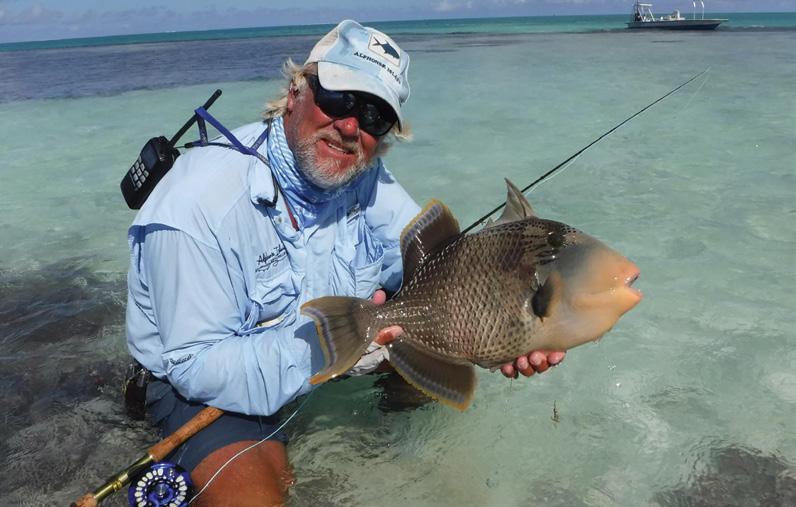
The use of nets made all the difference. Wayne getting ready to land a milkfish for a guest on his Maverick. Classic yellowmargin trigger. True clowns of the flats that have become a whole genre of their own. Super special and super addictive.

At the time, Wayne, Arno and the other guides had been fishing a Lefty Kreh fly called the H2O. “It’s white calf tail with a green calf tail topping. On the back of the fly, it’s got a little bit of UV pink chenille. It’s tied bend back, so it’s basically a shrimp with an egg sac on it and it’s supersimple. It’s got like two strands of crystal flash and it was originally tied on a small longshank Tiemco similar to an 800S. That was THE fly, our go-to fly for tailing bones. We were all fishing with it.”
Wayne says, “We had a situation where there were a lot of mature milks feeding on the dropping tide of St Francois in the channels. We used to ride over them going to and from the flats. It was a big joke and the guests used to love it because they’d get splashed. Little did we know that this was the fucking motherlode, Tutankhamun’s tomb, right there. One day, Arno and I were having lunch with guests on the flats. I was guiding a guy called Robert Block and his wife Jennifer. Arno also had two guests. We were camped up on a dropping tide, on the spur of a flat between two channels. It was one of those perfect days. Arno got there a bit earlier than me and had borrowed one of the guest’s 9-weights, set up with an H20. He was flicking the fly at

these huge 40-pound milkfish in the channels and when I got there he swore to me that one of them had turned towards the fly. With the guests settled with their lunches and happy with us going off and borrowing a rod again, I suggested we have another go. I had the rod, the fly was swinging towards the milks, and I saw a fish turn out of its feeding lane, and go for the fly. The fish tracked the fly. I said, ‘Arno, did you check that?’ He responded, “I told you!” So I cast again. The conditions were perfect, those fish were huge, and the water was crystal clear so I could see everything. I got the fly in front of the fish again and this time it did the thing I’d imagined so many times. It turned and ate the fly. This time Arno said jokingly, ‘You flossed it.’ I said, ‘No way, I saw it turn and eat the fly.’ Milkfish have these incredible radar-like, high-tech eyes and there’s no way it did not see the fly. Plus, I saw the fish eat! In the meantime, the fish took off and I had no plan for what I was going to do with it. I was running to the end of the coral as this fish was grey-hounding further and further away from me, shouting to Arno to get the boat.”
While Arno ran back to the boat, Wayne had no choice but to swim across the channel onto the next flat to avoid getting spooled. Despite his best efforts, the milkfish ended up popping him off. Though he came back to the group empty-handed, both Wayne and Arno knew the implications of what had just happened. The next day, with H2Os tied up overnight and rods rigged, both guides raced back to the channel with their guests to try to replicate what had happened to Wayne the day before. Wayne then proceeded to guide both Robert and Jennifer Block into milkfish, tailing the fish on the flats because in those days they did not have nets. One of Arno’s guests caught a milkfish shortly after. While they were a team, to say the competition between them and their guests was neck and neck would be an understatement.
“Robert Block was the first man to ever purposefully catch a milk on fly and Jennifer was the first woman to accomplish this feat. That evening, Arno and I phoned Chris and said, ‘You won’t believe what’s happened. We did it. We purposefully hooked milkfish.’ The lights were on.”
Predictably, Chris was over the moon. As per his initial plan, they kept news of this breakthrough under wraps even from the other operators on Alphonse and for the next two-and-a-half years they refined their flies and their approach to catching milkfish on fly. Wayne (the Milky Magic) and Arno (the Milky Dream) both developed flies for milkfish that although they are remarkably similar, do differ slightly.
The milkfish story then took an unexpected twist. Despite the team’s agreement on a media embargo, Joe Daniels from Wild On The Fly magazine came to the island because, despite Chris’s ideas around NDAs, he had got wind of the milkfish breakthrough through some loose lips. “I was on leave and this guy arrived from the States to do an interview on the milkfish fishing. Arno got the magazine coup because I wasn’t there.”
Camo coral super 6 matched with a Sage TCR 8-weight, 12 lb flouro tippet and a size 8 Orange Christmas Island Special. Add tailing bones in skinny water and you have heaven in Wayne’s book. One Palm Island, St Francois on a neap push.
Blue spangled emperor. One of Wayne’s favourite flats species that smash crustacean patterns, pull like mad and are highly underrated.

“WE USED TO RIDE OVER THE MILKFISH GOING TO AND FROM THE FLATS. LITTLE DID WE KNOW THAT THIS WAS THE MOTHERLODE, TUTANKHAMUN’S TOMB, RIGHT THERE.”
Bearing in mind that this all happened a quarter century ago, some details are going to be foggy, but when you compare Wayne’s account to the one Arno recounted to us in Issue 3, there are two distinct sides to the story (e.g. the year the breaktrhough happened and who hooked and caught the first milkfish). Arno’s account also leans towards the mystical saying that the idea for his fly, the Milky Dream, came to him… in a dream. Perhaps that’s the creative licence one adopts when asked to tell an origin story again and again. In contrast, Wayne, the conservationist and former hatchery manager, leans towards the scientific when talking about the Milky Magic fly.
“The milkfish are eating this blue copepod macroplankton. It’s a very aggressive algae feeder that builds up in numbers and is highly mobile. They’re like cocaine to milks, they lock onto them and just lose it. One of the things I did with the Milky Magic is put a specific blue
flash onto the nose. It’s also got ice dubbing up against the wing, teased out a bit, plus a very specific UV pink for the egg case. So it’s an algae-shrimp-plankton-copepod pattern with at least five milk stimuli in it. It covers all the bases and is incredibly effective.”
Ultimately, Arno got the big interview scoop on the island, telling it his way. Wayne still got some acknowledgement, as his Milky Magic fly is recognised as a top milkfish pattern and is available for sale through the Fulling Mill website. Perhaps as the final neutral arbiter over this moment in fly fishing history, their former employer Alphonse Fishing Co.’s website reference page for milkfish features both the Milky Magic and the Milky Dream. If I’m honest, I’d struggle to tell the two flies apart.
Having interviewed both men, and knowing that no one save for the milkfish can confirm what went down, I’m left wondering if there could not just be two Milkmen?
Beautiful, classic and full of fight. Photo op from one of Wayne’s best ever milkfish sessions with Vaughn Driessel at the wreck, St Francois. Nine milkfish landed between them.
“I’VE BEEN VERY LUCKY. I BASICALLY JUST TOOK OFF MY GUIDING SHOES AND PUT ON MY CLIVIA SHOES.”

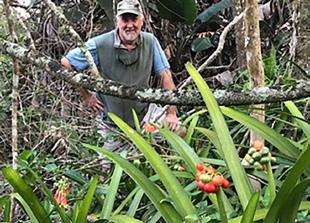
When the end of Wayne’s Seychelles life came, it came fast. The pandemic descended in 2020 and he had no choice but to board one of the last planes leaving Alphonse. It was a particularly stressful, difficult period for Wayne. He managed to make it home to Morgan Bay just before the borders closed. Similarly his wife Jane, who he met on Alphonse, was also lucky enough to catch one of the last planes out of the UK. Together again in Morgan Bay, they took stock.
Wayne says, “I knew the day would come. I’d left Alphonse a couple of times, emotionally, physically and mentally, but this time it was done and I’ve never been back. The plan was always to have an exit strategy. Thank God I did because when Covid came, everyone got chopped off at the knees. Jane and I decided we had no other option but to make the clivia thing work. It went from being a hobby that had always been part of my life to being a full time, very successful business, Wild Coast Clivias. I’ve been very lucky. I basically just took off my guiding shoes and put on my clivia shoes.”
Over 20 years of eight months on, four months off Seychelles guiding, Wayne had used his time back in South Africa to work on developing his property with a view to turning it into a nursery one day. The Transkei is a wild, rural area of great natural beauty that property developers and mining houses would love to ruin with beach-side condos and mines, if only the locals would all sell out and if only the deep kloofs running to the ocean didn’t make access extremely difficult. It’s also a place where his clivias (and their host) are happiest.
“These things hook you. It’s a bug, a disease. We call it clivianitis; you’ll never be the same. They’re very clever
because we end up working for them. I work for the genus Clivia. The fact that I’ve been able to make it into a business is just a bonus.”
A month after the interview Wayne sent me a video of himself from his balcony in his underpants armed with a 12-weight, “fighting” a fish made of weights on the ground floor. He was prepping for a trip to Angola to go visit his old Alphonse buddy Andy Coetzee*. Saying things like, “big tarpon!”, “this thing is running” and “short strokes”, he guided himself through the fight.
As Wayne whooped and hollered at an imaginary tarpon, I couldn’t help but think about his two parasites doing a jolly sort of high fives handover of Wayne’s controls, like the baton exchange in a relay. I considered that the rest of us are no different. We just need to be careful about what parasites we let control us... e.g., lice on salmon or Fox News for anyone over 50. In Wayne’s case, he got the balance just right. He lived the young person’s fly fishing dream for a lot longer than most and made his name where it mattered. Now he’s got the girl, the name, and another life on the go as well, one that makes him a decent living and that comes with even more respect from a different world. He’s also got new titanium hips so he can fish and wade the flats again should he wish to.
His mum, his dad, even Bukowski, would all be proud.
What a dude.
* Wayne is now back, part-time mind you, in the world of guiding, helping Andy Coetzee out in Angola at Skimmer Island lodge (skimmerisland.com). The only hope those poons have, is that clivias are competing for Wayne’s attention too.
A beautiful rainbow trout from a small syndicated stream. Tributary of the Rhine. 2016 Cologne, Germany. Photo Joern Heiner.
With his favourite clivias, Clivia nobilis, in a remote Transkei Forest locality.

Wayne’s wife Jane took this shot of him at play in paradise. The flats of St Joseph, a truly happy place for him.
LATEST RELEASES SALAD BAR

TFO – SOLUTION FLY ROD
Fly fishing, if you think about it, is a problem solving exercise. You need to figure out how to overcome a spread of challenges. Having a rod that makes casting, striking and fighting fish as easy as possible, helps. Whether you are a midlevel angler or quite advanced, TFO’s Solution series provides you with high level components and a high-performing rod action built on a trusted and well-respected TFO blank. This 10-rod series spans 8 to 10 feet, covering everything from small water trout to larger anadromous fish. Built on a high modulus graphite with a clear coating (aiding with a noticeable light weight and quick recovery), all rods come with premium cork handles and half (on the 3-weight) or full wells grips (4-8-weights). Expect fighting butts on the 6-8-weights and premium REC black pearl recoil guides and double-foot, smoke-anodized snake guides across the range. Whether casting small dry flies, multi-fly rigs under an indicator, fishing streamers in a river or still water applications, the Solution is the answer to most freshwater problems. tforods.com, wildfly.co.za
“THE
SOLUTION IS THE ANSWER TO MOST FRESHWATER PROBLEMS.”
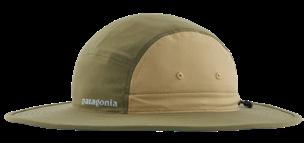
PATAGONIA – QUANDARY BRIMMER
A ‘quandary’ is a difficult or challenging situation and a ‘brimmer’ could be a full cup so to speak. The implication? Your cup will floweth over with epic challenges shouldth thouest weareth thist fine headwear. Built for hot days on the water, it features a wide, glare-reducing brim, a vented crown, a quick-wicking sweatband, and a secure toggle closure to ensure it’ll stay on your melon even if the Sou’wester be howling. patagonia.com, xplorerflyfishing.co.za
YETI – FRENCH PRESS
Considering that a “French letter” is a condom and a “French kiss” is a proper snog, you might imagine that a French press is our Francophone friends’ take on the missionary position, but you would be wrong. It’s plunge coffee, which when made in this stylish, nighon-unbreakable French Press from Yeti is not only going to super-charge your day, but make you look good while doing it. Available from Upstream Fly Fishing in various colours and in both the 34oz (0,964L) and the 64oz (1,814L) versions. yeti.com, upstreamflyfishing.co.za
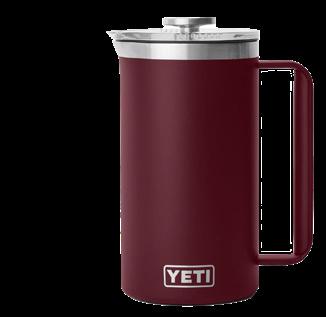





















ORVIS – HELIOS™ D FLY ROD
If where you fish requires some proper distance on your casts, then you should probably take a look at Orvis’s new Helios rods with the “D” designation. While Orvis’s other sub-range is the “F” range which is more focused on delicate presentations, the Helios D is all about distance. That’s not to say the accuracy isn’t there - it is. But if you need to bomb out long distance casts through wind to rising yellows at Sterkies, fire a Stella into structure at Jozini or hit a pancaking grunter through a blustery Southwester on the Breede, the Helios™ D Fly Rod is the go-everywhere, fish-anything option. Expect a fast loading rod with heavy lifting power for big fish, efficient energy transfer for long casts and excellent accuracy at any distance. Made in the USA and backed by a 25 year guarantee. orvis.com, flyfishing.co.za
XPLORER – BACKCOUNTRY FLY RODS
So The Mission has worked its magic on you and you want to take up fly fishing as something to do with your spawn? Then you are probably going to want to take a look at Xplorer’s Backcountry range of entry-level rods. Available in a 7-foot 5-weight iteration for kids and a regular 9-foot 5-weight option for large kids like you, the Backcountry covers you for most freshwater (and even a few saltwater) fly fishing situations. With a medium-fast action and durable 4-piece graphite construction, it offers easy casting of nymphs, dries and streamers and solid performance at an affordable price. If you need a matching reel, Xplorer can set you up with a combo outfit. xplorerflyfishing.co.za
FISHPOND
– NOMAD® YAMPA HAND NET
While it sounds like a name toddlers give a grandfather (e.g. Peepaw, Humpy), the Yampa is a net from Fishpond’s Nomad range designed for anglers who value versatility and performance in a compact platform. Featuring a slender handle made from carbon fibre and fibreglass for lightweight durability, buoyancy and effortless manoeuvrability, it’s a great choice for walkwade applications. As we have come to expect from all Fishpond products, this net seamlessly integrates into any of Fishpond’s pack or bag slots. fishpondusa.com frontierflyfishing.com

FISHPOND – HONCHO REEL CASE
By now everyone has seen footage of luggage handlers throwing bags around like it’s the caber toss at the Highland Games, but when it comes to your precious reels you’re probably not always confident about taking them on planes as carry-on (thanks to over-zealous security checks where your lines are identified as an assassin’s garrotte). Either way, with space in the removable, padded dividers for up to 10 reels, an impactresistant bottom (a feature our art director Bod also sports) and a cushioned interior, Fishpond’s Honcho Reel Case is the safe padded home your reels deserve while in transit (or even stored at home). fishpondusa.com, frontierflyfishing.com
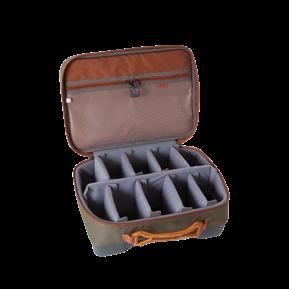





SCIFLIES – SALTWATER RANGE
Flats trip on the horizon? If you are planning on catching a spread of shrimp and crab-munching species like bones, triggers, perms, golden trevally, then you should take a look at what’s coming out of Mbombela-based ScientificFly with their new SciFlies saltwater range. The initial line-up features Gotchas in pink white and tan, Christmas Island Specials in tan/orange, Green Machines in tan /chartreuse, Pillow Talks in chartreuse/white, Golden Knights in tan/ gold, Fleeing Crabs in tan/orange and Spawning Shrimps in tan, but the range will expand soon with a wider variety of patterns including a tungsten-weighted selection. scientificfly.com
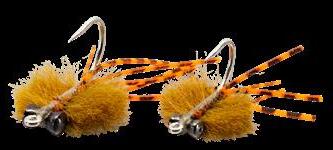

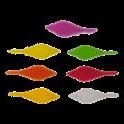


SEMPERFLI – FOAM MAYFLY & BEETLE BODIES
If you aren’t into body building yourself, but want the benefits of great beetle and mayfly bodies tied into your flies, we suggest you take a look at the Semperfli options available at Xplorer. Available in 12mm (21 bodies) or 17mm (12 bodies) packs in tan or black, Semperfli’s beetle bodies feature long ‘Tie In Tags’ making it easy to secure them to the hook. Top tip: combine the bodies with some of Semperfli’s Synthetic Peacock Herl for a buggy high floating fly. Meanwhile, the mayfly bodies are perfectly cut Ephemeroptera bodies designed to match the hatch. Made from durable and condensed closed-cell foam, they have three holes, one for a tail fibre fibet and two for hook positioning regardless of which way up you tie your body in. Each pack contains 12 mayfly bodies. xplorerflyfishing.co.za
FULLING MILL – JENKINS’ POPPER HOPPER OLIVE BARBLESS
The perfect pattern for the buoyant end of a washing line when your blobs and boobies aren’t cutting it, the Olive Popper Hopper can also be fished as a dry fly in windy conditions. Tied with a thorax cover of foam, as well as the popper head, this fly hangs perfectly in the surface rather than on it, giving more positive takes and hook ups. fullingmill.co.uk flyfishing.co.za
VENIARD – CENTIPEDE BARRED RUBBER LEGS
Strapping hoppers, nymphs and streamers for the season ahead? Then we recommend you throw some legs in like a psychedelic-stockinged Dr Seuss character. These extra thin barred legs from Veniard are just the ticket for all manner of leggy, buggy delights your fly box demands. veniard.com, upstreamflyfishing.co.za




Shallow. And Deep.
Personality, performance and the good looks to back it up.
DIAMONDBACK – GENERATION IV NYMPH
Designed by nutty professor and rod designer Joe Goodspeed, Diamondback’s Generation IV Nymph series was made with serious nymphing nerds in mind. Available from 1 to 6-weights and 10’ and 10’7” lengths for extended reach and line control, each rod is engineered with a specialized action profile to optimize presentation, tippet protection, and fishfighting capabilities while maintaining superior sensitivity and control. If it’s precision, finesse, and versatility you want, then this range of ultralight rods is for you. diamondbackflyrods.com, xplorerflyfishing.co.za
DIAMONDBACK – IDEAL NYMPH REEL
While you can fiddle around with non-nymphing reels, ultimately you are going to want a specialised nymphing reel for your specialist nymphing rod. Diamondback’s Ideal Nymph reel is a complex five-axis machined reel with a 40-gram adjustable weight system designed to optimize the performance that tactical nymph anglers require from a fly reel. It features a large diameter spool that spins easily with one quick turn - allowing several feet of line to be picked up very quickly so you can get fish on the reel fast - and the extra narrow gap between the frame and spool minimizes the potential for line getting caught between surfaces. As for fighting fish, it’s packing more drag than a nymph reel could ever need. diamondbackflyrods.com, xplorerflyfishing.co.za
SIMMS – HEADWATERS HIP PACK
More of a hipster than a chest, sling or vest angler? Optimized for on-water organization, the new 10L Headwaters Hip Pack from Simms divides, conquers, and corrals your crap (but not your issues). Expect a 630-Denier build, a compression-moulded workstation for on the water rigging work, convenient net storage, a comfortable shoulder/neck strap for evenly distributing weight while on the move and plenty of docks, pockets and more. simmsfishing.com, frontierflyfishing.com
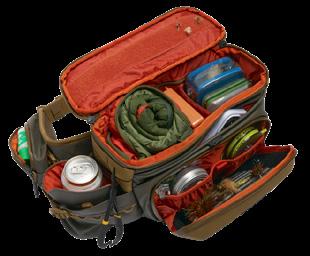
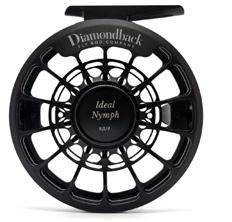
SIMMS – HEADWATERS CHEST PACK
Looking for sleek stream storage that is there when you need it but out of the way when you fish? With a full feature chest pack up front and a simplified back storage compartment with an integrated net holder slot and D-ring, the 8L Headwaters Chest Pack from Simms may be the answer. Built from rugged 630-Denier, it features a tough compression-moulded workstation, hydration housing in the back, and a quick-release design that lets you remove and reattach the front assembly to waders or, if you have one, your Simms Headwaters Backpack. simmsfishing.com, frontierflyfishing.com























































































YOUR GOLD?































While RIO makes dozens of specialty fly lines, many anglers still want that one tried-and-true delivery system that simply handles it all. Gold Series multipurpose lines unlock the potential, powered by smart taper designs and performant weight distributions that sync with the wide-ranging opportunities you’re used to seeing during any given session. And because no region, water type or fly box is the same, we’ve expanded Gold into three distinct classes — each tailored to your multipurpose program — making Gold Series the new standard for all-around versatility.











































































KORKERS – STEALTH & SALT SNEAKERS
For those that want boots, but don’t like the weight they usually come with - Korkers brings you not one, but two new options that are as light and comfortable as sneakers, but tough as a boots. The freshwater iteration, the 2.2lbs Stealth Sneaker features Korkers’ proprietary Kling-On Rock™ outsole giving you lightweight, flexible performance and a solid grip on dry and wet rock. Made of fast drying, hydrophobic materials (for faster dry times which lessen the chance of spreading invasive species), these boots also incorporate ballistic seamless loom technology in their construction giving them increased abrasion-resistance and supreme durability. While wading in and out of rivers all day, water flows through internal channels then out the midsole ports, quickly removing excess water and weight. On the lace front (and in a subtle nod to sneaker culture), you get two sets of laces, black and red, to customize as you see fit. In the 1.8lb Salt Sneaker, many of the specs (comfort build, ballistic tech etc) are the same, but there are notable differences. They use non-marking Kling-On® Deck rubber outsole delivers incredible grip on wet and dry surfaces. They also have an industrial-grade, puncture resistant internal plate to protect your feet from sharp coral and other objects. Both boots come with a one year warranty. korkers.com, xplorerflyfishing.co.za

AHREX PR370 – 60 DEGREE BENT
ORVIS – MIRAGE® LT REEL


When Orvis’s R&D department were working on the Mirage, they probably had folks misunderstanding what they meant by the “Mirage” (like we do with people thinking The Mission is a nod to *puts camo paint under eyes* some sort of para-military role play). It’s not “mirage” like the fighter jet, but more “mirage” like that shimmering oasis you might see in the desert, something that’s almost not there. In this reel’s case, that’s because it’s so light and the new version is 30% lighter and narrower to balance lighter rods yet still offer legendary Mirage engineering and performance. The Mirage LT features a lighter version of the sealed and maintenance-free carbon and stainless steel disc drag system that adjusts from zero to full drag in a single drag knob rotation. With zero start-up inertia and precise low-end control, it eliminates line shock and protects light tippets with its smooth drag, but still gives you tons of stopping power. orvis.com, flyfishing.co.za
Need to get jiggy with it? If the fishery you have plans for demands a jig-style fly bounced hook up along the bottom, then you might want to consider the Ahrex PR370 60 degree heavy-duty jig style hook. Made for weedless performance and bottom bouncing it features heavy wire, a large hook gap and sports a 60-degree bend in the shank. Great for all situations from bass to kob when you find yourself reaching for a Clouser. Available in size 2/0, 4/0 and 6/0 from Upstream Fly Fishing. ahrexhooks.com, upstreamflyfishing.co.za
AHREX – PR378 GB SWIMBAIT
We know, we know, this looks more like something that should have a soft plastic attached to it, but while Ahrex’s GB Swimbait is inspired by the Texas Predator hook, it was designed (in collaboration with big fly nerds Gunnar Brammer and Paul Monaghan as a real fly hook. Perfect for weed less designed flies, it offers you plenty of room to tie on rattlers and/or weights. Available in size 2/0 to 6/0. ahrexhooks.com, upstreamflyfishing.co.za



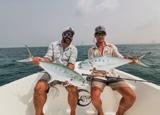












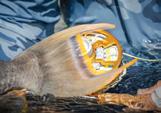





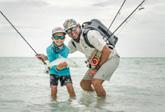
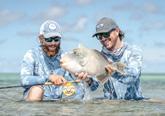





















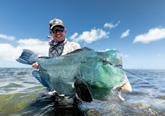









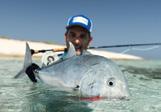
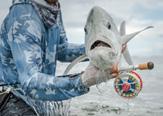

















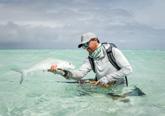


ORVIS – MEN’S SUN DEFENSE HOODIE
The name says it all. If you want to protect yourself from the great fiery orb in the sky, you need a hoodie like this one which will keep you cool and protected so you can focus on the fishing. Sporting breathable mesh-like knit and UPF 50+ sun protection, it’s designed with an active fit for maximum airflow and comfort. It dries fast and wicks moisture from your sweaty pits and back to keep your temp down in the Amazon, the Kalahari desert or wherever you get your fishy kicks. Bonus - it also features Orvis’s OutSmart® Fresh odour control so you can live in it for a few days without losing too many friends on account of your stankiness. orvis.com, flyfishing.co.za
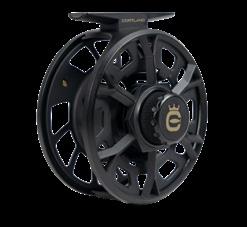
CORTLAND – GUIDE SERIES REELS

You might have assumed that Cortland specialised in lines and while that certainly is a focus, they have more offerings too. Take reels, who better to build reels than a line company? Their Guide Series Reels are a great example. Designed around a smooth, large centre disc drag, these reels come in two sizes, 3-5 and 6-8weight, are built from cast aluminium and can be switched from left to right hand retrieve with ease. Offering consistent stopping power, while remaining inexpensive, they are the ideal option for both guide rigs and beginners. cortlandline.com, wildfly.co.za
CORTLAND – 444 HOVER LINE
For fish, the upper water column is kind of like the Golden Circle at a Rammstein concert. Extremely close to the action, but most of the time you are not in danger of being set on fire by the pyrotechnics. Cortland’s 444 Hover Fly Line features a unique, neutral density blend of polymers for targeting those close-to-the-action fish right below the surface. That means it will sit under the surface film and remain at that level throughout the retrieve. With welded loops on both ends for easy leader and backing rigging, the Cortland 444 Hover Fly Line is available from 6 to 8-weights. Perfect for fishing in still waters, whether using small nymphs, wet flies, or streamers, this line keeps your flies in that Golden Circle upper water column and in the action. cortlandline.com, wildfly.co.za
CORTLAND – GUIDE SERIES RODS

Again, going for that sweet spot with an affordable product aimed both at guides, but one that’s also suitable for anyone looking for a hard-charging rod - Cortland’s Guide Series rods come in fresh (including a Euro Nymphing option) and saltwater models. Each four-piece rod is built with quality, fast action, light weight graphite that can withstand wear and tear from anglers of all skill levels. Featuring aluminium reel seats, fighting butts (on the 10’ 4-weight, 9’ 6-weight, and 9’ 8-weight, a Cordura rod tube and a two year manufacturer’s warranty, you’d be hard-pressed to find a better no frills, all-action rod for your quiver. cortlandline.com, wildfly.co.za








PAY DAY
LOCAL WATERPROOF BACKPACK MANUFACTURER WALT’S VAULT, AND A MONTE BURKE COMPILATION
Photos. Platon Trakoshis, Matt Kennedy
THE WATERPROOF PACK - WALT OTTER 30L
When it comes to waterproof backpacks, keeping things dry is the one and only thing they need to do. So, when a new brand comes along, something special needs to set them apart and no, being “more waterproof” doesn’t count as an improvement. We knew it would have to be the finer details setting local brand Walt Gear’s 30L Otter waterproof backpack apart from the international heavy hitters.
To put the Otter to the test we sent it with Platon Trakoshis onto the banks of the stormy Breede River estuary, then with Matt Kennedy on his stand-up paddleboard around False Bay and, finally, into the day-to-day world of photographer and digital nomad Nick van Rensburg.
ON THE BACK - PLATON TRAKOSHIS
It’s a solid bag, made well out of high-quality materials and built to last. It’s clear that it has been well thought through during the design phase and has a lot of practical elements that make it a useful bag for any outdoors person, especially for those spending time in or around water. I found the bag very comfortable and it has a solid back section that holds the soft sides together, keeping it structured. The adjustable straps work well, and I love the old-school metal double-ring strap controls and adjustments. Not only do they work as well as modern plastic clips, but they won’t break easily either. It’s the perfect bag when you need to carry a lot, to keep everything dry and to go on a journey.
Then there are the neoprene strap holders. Man, I love these. As a fly fisher, when I’m casting and fighting fish, straps tend to get in the way of fly lines. Bags I have used in the past have had elasticated straps, which always lose their elasticity and stop functioning properly. Well thought out, Walt.
A strong feature on the bag is all the slits on the front and side of the pack for attaching things. The bag I was using had a detachable hard case, which was very useful for small, regularly used items needed for quick access, like fly boxes, knives, etc. With the included Velcro straps you can attach a spare rod or anything else that can’t go into the bag.
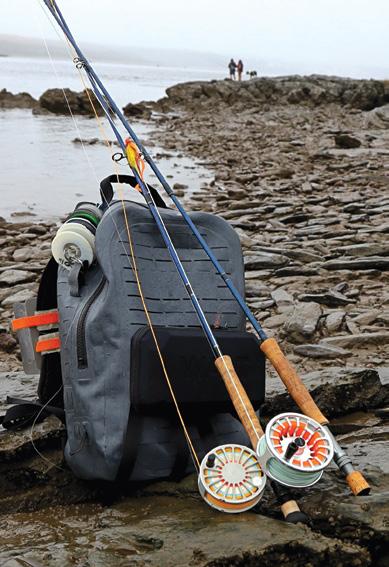
ON THE MOVE - NICK VAN RENSBURG
Having come from an outdoor product development background (Ed: Nick worked for First Ascent), I’m generally quite particular when it comes to testing gear. As their first serious backpack that’s now on the market, I can confidently say Walt Gear have hit the ground running. The Walt Otter 30L presents a seriously exciting option for those looking to invest in a high quality, durable and reliable waterproof bag. As a photographer and fly fisher, bags that claim to be waterproof are something that I’m always skeptical about, because risking your expensive camera gear on a river crossing in a boat, or in the surf or in heavy downpours, is something you ultimately don’t want to worry about. Having played with the bag for a few weeks, it’s certainly been impressive and ranks right up there with some of its international competitors.
For me, the best part of this is that it’s been designed, tested and manufactured in South Africa and it comes with a lifetime warranty. I’ve been in contact with these guys since they started this project and can personally attest to their commitment to quality. This is a brand to keep your eyes on. Local is indeed very lekker.

ON THE DECK - MATT KENNEDY
Fishing from a SUP is a balancing act in more ways than one way. Generally, I have more gear with me than a sling or hip pack would allow, but I also have to consider space on board. Trying to access the contents of a 30L backpack while it’s still attached to your body is next to impossible so, when I’m sitting, kneeling or paddling, a bag like that stays on the wet “deck”, usually secured with a leash. The sturdy box-like shape of the Otter means that the bag can support itself upright on my paddleboard without crumpling in on itself. I can confidently say that the pack’s durable material and TIZIP zip closure makes the bag watertight against wave action.
The permutations of gadget attachment options are virtually endless. If the pack is predominantly on your back, then there are many options for zingers, carabiners and fly patches. Another huge advantage is how Walt have minimised their snag zones, with rounded buckles, neoprene strap holders and a sleek smooth silhouette. The last thing you want during a perfect cast is having your running line caught up on your pack. waltgear.co.za
EXTRA THOUGHTS
1. While many fly anglers like to keep all manner of gear strapped to their bag, it felt like the 30L Otter might actually have too many attachment points (if there is such a thing). Perhaps a little less is more?
2. Although not a challenge unique to this brand, a large waterproof pack can feel like a gear-swallowing chasm. We’d love to see some sort of removable compartments to help separate lunch from your leaders, and your fly boxes from your bankies.
3. The bag is a little too big for shorter trips where you don’t need to carry too much, so we hope the Walt team are developing either a smaller backpack or a sling bag made from the same materials.

THE BOOK - RIVERS ALWAYS REACH THE SEA: ANGLING STORIES, MONTE BURKE
One of our favourite contemporary fly fishing authors is Monte Burke. You might know his name from Lords of the Fly, his wonderful account of the 1970s Florida tarpon scene and its colourful characters. Or perhaps you were already a fan of his earlier work like Sowbelly, a deep dive into the crazy largemouth bass comp scene. His latest release Rivers Always Reach the Sea (a line from the Led Zeppelin song, “Ten Years Gone”), is an absolute must-buy if you love excellent storytelling, astute profiles and profound longform analysis of the weird and wonderful aspects of both fly fishing and other forms of fishing. Then there’s Shark Bait, where Burke joins a “skishing” (open water swimming and fishing) practitioner, fishing for stripers in New York and The Legend of Lefty, Burke’s stellar portrait of fly fishing’s biggest legend. This collection spans continents from remote waters of Russia, to Chilean rainforests and congested inner cities. In Rivers Always Reach the Sea Burke also introduces you to some of the sport’s greatest characters, like tarpon sensei Andy Mill and The Happiest Man In The World, the foul-mouthed AC/DC-loving Captain Frank Crescitelli. We wager it will make you pretty happy too. pegasusbooks.us
BUCKTAIL FLIES
BEASTLY BUCKTAIL BAITFISH FLIES TIED BY ANDRE VAN WYK , AKA DRE, OUR VERY OWN SOUTH AFRICAN CHEWBACCA. SOME SAY EACH ONE IS TIED WITH A SIGNATURE STRAND OF HIS BEARD…
Photos. Matt Kennedy, Ryan Janssens

Who are you…?
I’m Andre van Wyk, a scruffy 45-year-old kid born and raised on the south coast of KwaZulu-Natal in South Africa. After high school I went to the University of Life in Grand Cayman for five years. I have called Cape Town home for the past 21 years.
I grew up fishing obsessed, and got into fly fishing at around five years old, and then into fly tying a couple of years later with my dad. I’ve delved into all forms of fishing over the years, but always came back to fly fishing. Over the last decade I’ve fallen more and more heavily into the fly tying. I don’t get to fish nearly as much as I’d like to ( does anyone?) so time at the vice gets me more “fishing” time so to speak, and having a creative outlet is something I crave.
What do you do for a living when not making the big bucks with BTF?
I co-own and operate a film and photographic service production company with my sister.
How does Bucktail Flies fit into all of this?
As Bucktail Flies is a relatively new entity, I’m still kind of figuring that all out. My wife encouraged me to start offering flies for sale because I was wanting to spend so much time tying flies and also had a lot of folks contacting me asking if I sell flies. So I decided to give it a go. I wanted to approach it a little differently instead of becoming a “fly factory” because, first and foremost, I didn’t want to lose my love for tying. I set out to tie what I enjoy tying and to see if people want to buy those flies, instead of specifically taking orders. Now it’s morphed a
bit into a mix of both taking orders and tying what I want and offering those up for sale. I had a website for a while, but the reality of my “real job” season during summer means I get very little time to tie or manage a website. Now I pretty much just sell via folks reaching out on the @bucktailflies Instagram page.
Rumour has it you’ve never tied a nymph? Why do you seem to exclusively tie large bucktail flies?
I have actually tied a fair number of nymphs… Just not many in the last 10 years. I started out on trout flies, so spun many a nymph back in the day, but there are folks who do it far better than I do, and who enjoy it more, so I’m happy to support them rather than frustrate the hell out of myself tying nymphs.
My flies are all about the material – bucktail. I fell in love with it through the incredible books and patterns and philosophies of the late Bob Popovic who so kindly shared his incredible knowledge, skills, ideas and patterns with the fly fishing and tying world. There is something magical about bucktail: what you can do with it, how you can manipulate it, its unique nature. Every tail is different, and there’s a constant need to adjust your tying to work with the material. I’m also in love with the end results of a well tied big baitfish fly and the way they look, both in and out of the water. In my opinion, nothing swims like a well tied bucktail fly.
What’s next for Bucktail Flies?
Being a married man now, I fear my days as a nude cover model are over, but you never know. Heading into winter means my real job is a little quieter for a while, so I’m gearing up to be tying in earnest for the next couple of months. My order book is currently pretty damn long and a lot of patient folks out there are waiting for flies (which I’m extremely grateful for). I am very much looking forward to getting flies to them and in front of some big nasty fish!
Got a GT Seychelles trip planned? Going for South American peacock bass? You can get your beast on if you contact Dre on Instagram @bucktailflies.
MORE COWBELL DRE?
Follow us on YouTube and watch Dre’s tutorials.
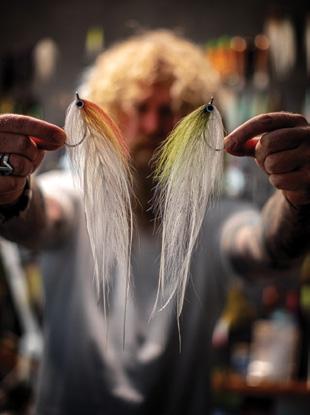
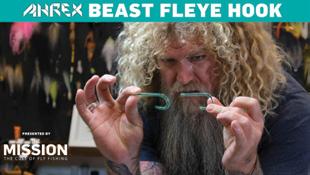

RACK ’EM AND STACK ’EM
THE MISSION HAS HAD A FEW RODS COME THROUGH ITS DOORS RECENTLY, INCLUDING A BASS BULLY ECHO 6-WEIGHT, A MULTI-TOOL IN THE SHAPE OF HORIZON’S NEW NITRO 8-WEIGHT AND A FROM-THE-BRICKS BLASTER TFO 10-WEIGHT. HERE’S WHAT OUR TESTERS FOUND.
Photos. Brendan Body, Conrad Botes, Jazz Kuschke
ROD: HORIZON NITRO 8-WEIGHT. frontierflyfishing. com, horizonflyfishing.com
LINE: SCIENTIFIC ANGLERS AMPLITUDE REDFISH 9-WEIGHT. scientificanglers.com
TESTER: MATT KENNEDY
Being a twenty-something year old, I’ve not yet had the time nor budget to amass a quiver of rods for every occasion, equation and species. I’d love a supple saltwater 7-weight for estuary grunter, a stiff 9-weight to throw sinking lines at tigers, and a staunch freshwater 8-weight for largemouth yellowfish. At the same time, I’d also love to pay rent and buy food.
Enter the Horizon Nitro 8-weight which, having tested for a few months now, I am confident is an all-rounder that can cover any situation without me feeling like I am lacking the right tool.
In short, this is a fast action blank offering both a reliable backbone in the fight and a sensitive tip, and, bonus, it comes in at a fraction of the price of high-end, 8-weight equivalents. The rod comes in a verdant green-mamba colourway and features an uplocking aluminium, saltwatersealed reel seat and a Flor grade cork handle.

In the hand, I found that the Nitro packs a considerable punch. This is no doubt thanks in part to Horizon’s new NANOHOOP™ technology. Regardless, by the third false cast, I could feel that this rod was hungry to sling the rest of the running line out. It helped that I overlined it with the 9-weight Scientific Anglers Amplitude Redfish floating line to deliver
bigger flies. Speaking of all-rounders, this line is more than capable of covering all your South African saltwater applications, as well as doing surface work on the Orange, Vaal and Zambezi River systems. Sure, you can get specific lines for each and every fishery if you can afford to, but ask yourself this, do you need to?
As for the fight, hooking into a particularly chubby 17.5inch spotted bass deep in the Tankwa Karoo, I could appreciate the 8-weight’s backbone. I could also imagine how the fighting butt would come in handy when dealing with bigger species like kob or largemouth yellows. Despite that bass throwing a few violent headshakes, the Nitro’s tip kept the line in steady contact with the fish but could handle a fair amount of horsing when it came time to get it away from snags and into the net.
‘What about aftercare?’ you might ask. One day, when I accidently but inevitably use my rod as a pole vault or jam it into the blades of an outboard motor and break the tip, I can simply turn to the rod sleeve and rig up again. That’s because the Nitro 8-weight and, in fact, Horizon’s entire Nitro range, comes with spare third and fourth segments. Even if you chew through the spares, Horizon’s got a good rep for prompt and fair customer care.
If you consider yourself a larnie, this may not be the rod you reach for first on a trip of a lifetime (though it would be for me), but I’d say it deserves to be along for the ride as a backup or even a generalist rig. For my purposes, I can throw Muishonde on the Orange River, Stellas at Sandvlei leeries, turd flies at grunter and even, one day, tiger clousers and a fast-sinking line on the Zambezi with this rod. Put simply, for South African conditions and species (outside of the trout-sized realm), this might just be the holy grail of rods, a true Swiss-Army Knife.
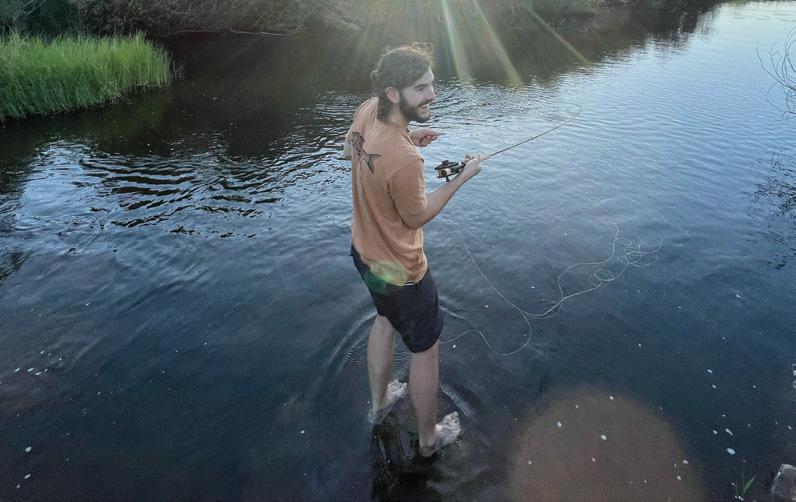
“I CAN THROW MUISHONDE ON THE ORANGE RIVER, STELLAS AT SANDVLEI LEERIES, TURD FLIES AT GRUNTER AND TIGER CLOUSERS ON THE ZAMBEZI WITH THIS ROD.”

ROD: ECHO 84B 6-WEIGHT. echoflyfishing.com
LINE: AIRFLO SUPERFLO COLD SALT UNIVERSAL FLOAT 7-WEIGHT. airflofishing.com
TESTER: CONRAD BOTES
A few years back Sage had a range of rods called the Bass II, specifically designed for and named after the various bass species one might target with them, smallmouth, largemouth, and peacock (okay, there was also a bluegill version, which was dumb on the naming front, but referred to really skinny bass water). These rods measured 7’11”, which was and still is a seriously unusual length. The theory being, that they would load fast and carry heavy flies to their target with ease. I never got to try them but, as a bass-fiend I would have loved to. They developed a bit of a cult following and I have no idea why Sage stopped making them.
Last year, stepping into that gap, rod guru Tim Rajeff of Echo Fly Fishing released the 84B range, the “B” standing for “bass”. Just an inch longer than the Sage Bass II series at 8-foot, the 84Bs are available from 6 to 10-weights, so you can tackle bass ranging from smallmouth bass in narrow rivers, right up through the weight classes to your peacock bass in the Amazon.
I got to test the 6-weight on some local smallmouth bass in the Western Cape. First off, I should state I’m not really one for shorter rods, for no reason other than it’s not what I am used to. When you fish 9-foot rods all the time, an 8-foot rod sounds like an odd length. I took it out to a dam which fires when the river that runs into it get some proper flow going after heavy rains. On this day there was quite a lot of flow.
Immediately, I was hugely impressed with the accuracy. Using a seriously long 12-foot straight leader, not tapered, with a strike indicator just a foot from the fly line, I managed to put a heavy fly into specific deep turbulent pockets with no problem. This is a technique I learned from the late smallmouth bass fly fishing guru Tim Holschlag, when he visited South Africa years back. You cast up current and retrieve the slack line, so your heavy streamer is basically drifting back. I use a very buoyant strike indicator, like an Oros, so it doesn’t get dragged under by the weight of the fly. Usually this is quite a clunky casting setup. Not only are you casting a heavy fly, but you are casting a bulky strike indicator too, which normally makes casting more awkward. This isn’t really the rod for that kind of fishing, but it handled really well. On reflection, the shortness of the rod was something I really thought would bother me, but it performed so well I completely forgot about it. Casting was lekker and I never felt like I lacked something. It handled the big smallmouth I caught in that session with no problems. Overall, I thought the rod was really great, the perfect bass rod.

I am keen to use it for more smallmouth bass and for yellowfish (Clannies, smallies and largies). I especially want to test it in small rivers in the Cederberg and Tankwa where you don’t have to cast that far, but you need accuracy casting into specific pockets in bushed in areas. For those kinds of waters my go-to rod weights are between 5 and 7-weights so it will be perfect. Plus, with the fighting butt it’s got plenty of beef and if I get into big fish, that shorter blank will give me more leverage and lifting power to pull a fish out of sunken logs or rocks. In these rivers and larger waterways too, you are casting to structure. You read the


water and know where the bass is likely to be sitting so you need to be able to place your casts very specifically and intentionally. That kind of fishing will also apply to our indigenous species like Clannies, largies and streamer fishing for smallmouth yellows and indicator fishing with crab patterns as well. I imagine if you head up to those bushed in rivers in northern Zambia where Leonard Flemming targets those blue yellowfish, this would also be a great rod for those conditions.
“YOU KNOW WHERE THE BASS IS LIKELY TO BE SITTING SO YOU NEED TO BE ABLE TO PLACE YOUR CASTS VERY SPECIFICALLY AND INTENTIONALLY.”
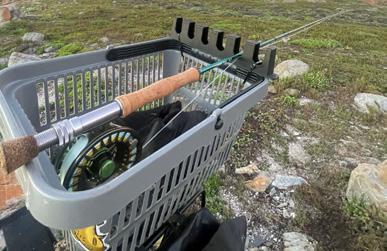
ROD: TEMPLE FORK OUTFITTERS BLITZ 10-WEIGHT. tforods.com, wildfly.co.za
LINE: CORTLAND COMPACT INTERMEDIATE 350G. cortlandline.com, wildfly.co.za
TESTER: JAZZ KUSCHKE
I’ve fished 12-weights before, but I’ve never actually owned one as I’ve never really had a reason to. I’ve chased GTs on borrowed gear in Maputaland and danced (unsuccessfully) with yellowtail offshore. A Gabon or Seychelles islands trip has never been on the cards, so while I lusted over owning one, there has just never been any justification to invest in a 12-weight, and I’ve always come back to the trusty nine. Until now.
After recently moving back to my motherland in the Eastern Cape and slipping back into old habits and the ever-thickening plot of the kob-from-the-beach project, I started asking bigger questions. About gear. About reach. About backbone.
Cue the TFO Blitz.
Technically, it’s a 10-weight. Spiritually, it’s a rod with the guts of a 12 and the grace of a nine. Born from the fertile and fevered mind of Blane Chocklett, the same mad genius who gave us the Game Changer, the Blitz was originally bred for blitzing bait balls and fast-breaking species like stripers, false albacore, bonito and bluefish. But it’s as at home in the surf of the Eastern Cape as it is on a skiff in Cape Lookout, USA. In fact, translate some of those species loosely into Saffa and you get ‘bonnies and shad’.
Blane may not have been responsible for the engineering of every line of graphite on this rod, but his fingerprints are all over it, especially in how it throws air-resistant Clousers and heavy brush flies with zero drama. The Blitz was made for onshore winds, choppy swell and big fish, for missions that might go sideways. It’s for when the surf picks up and the bait disappears and you still need to cast 30 metres into the wind to reach that gutter.
Now, let me backtrack. I’ve had a long-standing love affair with TFO, specifically, the BVK series of which I’ve had a
7-weight that’s been my go-to estuary rod for years. That rod’s done estuary work-horse service on grunter, garrick, shad and even my very first top-water, dead-of-night kob. So, when the Blitz showed up with its beautiful deep green finish and clean silver accents (and those stripping guides), it felt like seeing an old flame in a killer new jacket and boots. Familiar, but different. Sexy.
And then you notice the details.

Those RECOIL guides by REC aren’t just a marketing flex, they genuinely cut the friction on the Cortland Compact Intermediate 35-grain that it is loaded with and hold up under saltwater abuse. They snap back; they don’t corrode and they make a satisfying zip when you haul hard. The ultra-light, chromium-impregnated snake guides add to that sleek, responsive action. I used it fairly extensively in both the surf and off the rocks and the line shoots fast and clean with minimal false casting. It might not always be pretty, but it is ideal for the rough terrain and my ‘loose’ hometaught casting style. I appreciate that and the fact that I can ‘fish’ the rod when it matters in the often hectic, washy, windy beach and rock environments.
That said, it is fast, sure, but not ‘stiff,’ if you know what I mean. It loads with authority but never bullies. There’s feel. There’s control. It’s a rod that invites overlining if that’s your thing as it is for me. I found it sweet-spotted with a Cortland Compact Intermediate 350g. The 26-foot clear head punches through wind and lays down big flies where they need to go, sitting just right in that surfy, uppercolumn sweet spot. It’s fast-loading, slick-running, and seems to get the Blitz’s rhythm like an old friend. Together, they make a hell of a combo for hunting kob in the suds.
When it comes to flies, the combination of the 350g and the Blitz turns over the big stuff with ease. I have been fishing exquisite articulated squid patterns tied by Jurgens De Jager. Beautiful in terms of ‘matching the hatch’ in the centre of the chokka universe but hellish to cast. And when you are thigh-deep in surf, trying to put a 16cm 5/0 into a churning gutter at 30 metres with the wind quartering into your armpit, that matters.
Another thing I really appreciate about the Blitz is that, while super easy on the eyes, you don’t necessarily feel ‘sorry’ for it. Clambering over rocks, strapping it to my fat bike or paddling out on a SUP, that Axiom technology, Kevlar-wrapped, high-modulus carbon voodoo, means the rod doesn’t just survive the mission, it thrives on it.
Have I landed my kob-from-the-beach yet? At writing, not yet. By print… very well maybe. Every cast with the Blitz brings that silver dream closer.



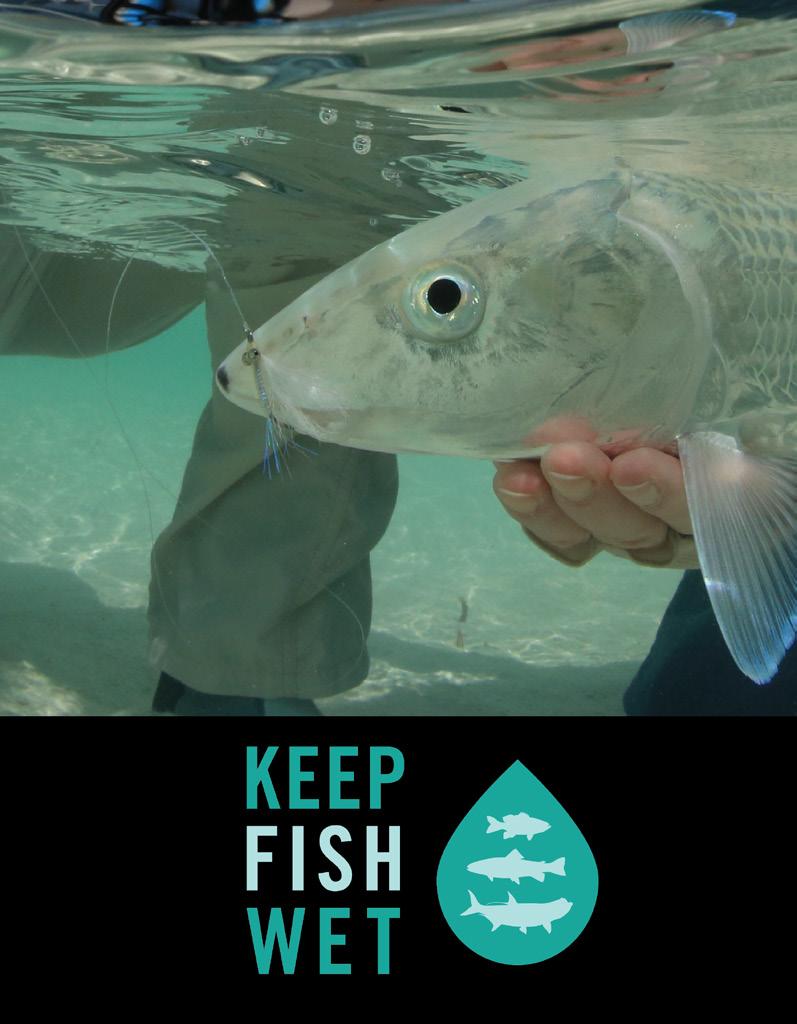
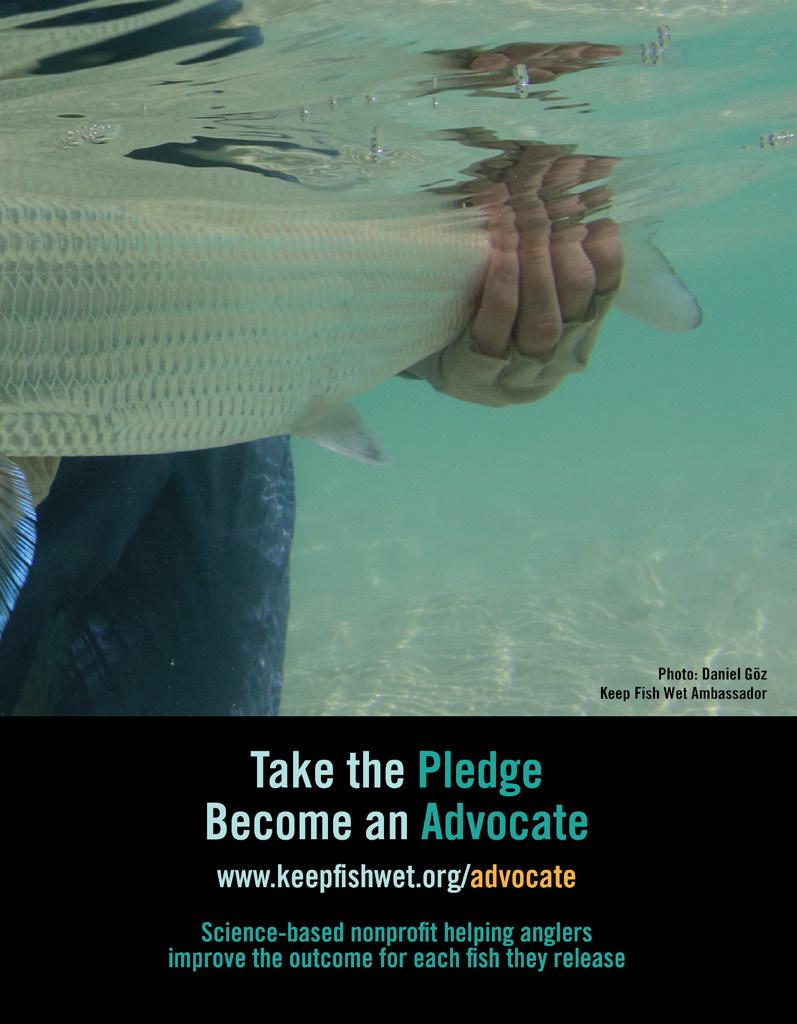
DAWIEGRAS
FEW PEOPLE KNOW SOUTH AFRICA’S PREMIER DRY FLY DESTINATION, STERKFONTEIN DAM, AS WELL AS DAVID WEAVER , AKA DAWIEGRAS, BRAVE DAVE. BUT HIS FLY FISHING SAVVY EXTENDS WAY FURTHER, TO THE SALT AND BEYOND, EXCEPT FOR SPOTTED GRUNTER. HE CAN’T HELP YOU THERE.
Photos. David Weaver
I was lucky enough to grow up in a Hooks + Bullets family, three elder brothers and a dad who were all keen hunter-fisher folk. We had many traditions in our family regarding fishing. One of them was the Redrod. It was loaded with a push-button close-faced reel. This rig had been handed down and used by the youngest in the family for years. It was an honour when I was considered old enough to use the Redrod on my own. While my older brothers and dad were casting Penn 49s and big spoons for yellowtail off the front of Whale Rock in False Bay, I would fish in the gully behind the rock for Hottentots, blacktail and, if lucky, a galjoen. So, besides a klipvis on a handline, where I used a smashed periwinkle for bait, the first fish that stands out in my mind was a Hottentot caught on the Redrod in the gully behind Whale Rock. The Redrod and reel are now proudly mounted on the wall in our cottage at Pringle Bay.
During the week I’m a chef for pigs and chickens. Jokes aside, we have a feed mill, manufacturing monogastric feeds. In terms of the jobs I’ve had, I have been a reluctant soldier, a camera salesman, a teacher, a miller, and a fly fishing/birding guide. During the summer months I guide on Sterkfontein Dam and now, in the winter months, I am getting more and more requests from people wanting to do LBJ (little brown jobs) birding weekends. That’s larks, pipits and cisticolas.
As a fly fisher, when someone asks about home I assume they are asking about home water. Somerset West was my first home, where we fished the Lourens River for trout. Then Dad was transferred to Modderfontein and so the Dullstroom municipal dam became our home water. I then spent my high school years at SACS in Newlands and, believe it or not, we caught trout in the Liesbeek River just

below the school grounds. After military service I enrolled at Pietermaritzburg University (now University of KwaZuluNatal). This move was motivated by the incredible reports that I had read in the Cape Piscatorial Society’s Piscator magazine of the lunkers that John Beams, Hugh Huntley and Tom Sutcliffe were catching in the Natal Midlands.
Richards Bay, which offered great birding and good fishing, would be my next home water. I lived there for 10 years, and that’s where I started dabbling with fly fishing in the salt. My first springer and garrick were caught on Muddlers Minnows. A mate returned from the USA with Lefty Kreh’s book, Saltwater Flies, and then the tying and the fanaticism for saltwater fly fishing really bit hard. Surrounded by keen fly tiers and enthusiastic anglers, we formed the Oxeye Flyfishing Club and for 10 years I lived in saltwater fly fishing paradise. Twenty-seven years ago I moved to Harrismith and discovered that even though there was a dwindling population of trout in Sterkfontein Dam, there was a new species to challenge me, yellowfish. I’ve lived here ever since and Sterkies is my home.

“TO BE ABLE TO DRINK THE WATER INTO WHICH I’M CASTING A LINE IS A PRIVILEGE THAT I WILL NEVER TAKE FOR GRANTED.”
Sterkfontein Dam is the best still water, sight-fishing, dry-fly destination in Africa, if not the world. To be able to drink the water into which I’m casting a line is a privilege that I will never take for granted. Then to be surrounded by the stunning Eastern Free State sandstone cliffs, with the Drakensberg looming in the distance, is like a soulrestoring tonic.
The worst part about Sterkies is the wind, and the best part is that after 25 years of guiding on the dam I am still humbled by that water. Never a day passes that I don’t learn something new. The very best thing is double hookups all day long on a caddis sort of day.
The smallmouth yellowfish of Sterkfontein Dam are the most beautiful, golden-coloured gamefish that you will ever encounter. They’re incredibly strong, wary, and they don’t suffer fools gladly. They behave differently at different times of the year and at different times of each day. They fight longer and harder than any other freshwater fish I have caught (besides carp). There are times when everybody is a professor and other days when they show the middle fin and you can’t buy a fish. They certainly keep you humble so don’t believe anyone who claims to “know” how to catch yellows on Sterkies, because, after 25 years of guiding on the dam, there are still many days where I don’t have the answers. There is nothing more soul destroying than spotting a cruiser, putting out the perfect cast, the fish swims up to the fly, hovers below it, then dips its head
David’s clients, the Kroger brothers, Ryan and Rob, doubling up at Sterkies.



and moves on. They can terrorise you like that. I consider yellows on Sterkies to be the pinnacle of freshwater fly fishing in South Africa. First, you must be able to see the fish, put in the perfect cast that turns over, and lands the fly within a metre of the fish. Then you need to have nerves of steel and do not dorado-strike when, and if, the fish accepts your offering. Once hooked, getting the fish to the net is not as easy as it sounds because these yellows box way above their weight category.
For Sterkies, I use a 5-weight rod and a large-arbor reel with a proper smooth drag, loaded with a floating line. I am always asked how long the leader should be, and my standard answer is, “as long as you can handle.” If you can turn over a 20-foot leader in a 15-knot wind, then do it. 5x tippet is only used on wind-free days and requires soft hands. As soon as there is chop on the water, we go stronger. This ensures that we can give cough mixture and get the fish released as quickly as possible. A 5-weight rod diminishes casting fatigue; a large-arbor reel allows you to pick up loose line far quicker; a floating line is all we use because we don’t go to the dark side. So there’s no use for a sinker.
My father always said, “Don’t leave fish to go find fish.” Very apt on Sterkies. The best advice that I can give on Sterkies is... “Don’t cast where you can see there are no fish, rather cast where you can’t see there are no fish.”
I am most proud of my two beautiful daughters.
The greatest party trick I have even seen was from a mate in Richards Bay who had a glass eye. One evening in the yacht club, a girl we were chatting with asked us to, “Please keep an eye on my handbag while I pop to the loo.” Joe obliged, removed his glass eye and placed it on her bag. She fainted.
If you could only use one fly on Sterkies, then it would be one of Hans van Zyl’s Purple Beetles. They are durable, float well and imitate a whole range of the beetle population found on the water. We do use different beetles at different times of the day and in different parts of the dam. Purple beetles, early and late and on dark days, mainly on the western shores and copper ones on the eastern shores on bright sunny days. As far as hoppers go, it is vital to look at which hoppers are around. Walk through the grass along the banks and take note of the hoppers that are there. Size is more important than exact colour matching. We then only use hoppers along the banks with an offshore wind, where the chances of them blowing onto the water is greater. Hoppers are also a favourite in the scum lines.
When it comes to ants, we generally have three hatches. The tiny 20# black ants hatch mid-morning, late season, and they are impossible to imitate. It’s a guide’s worst

nightmare. If you manage to get an imitation on the water at the start of the hatch you can still catch but, once the fish tune into the ants’ formic acid, then even a perfectly tied 24# black ant pattern on 6x tippet doesn’t work. In mid-season we get the small red termites hatching around midday and this is the hatch we dream of. And then in late February/March we get the large termite alates after a thunderstorm and this is also great to witness but tough to convert. Caddis patterns catch a lot of fish in the right conditions. My fly of choice, if I get a chance to cast a line, is an F-fly.
Something I have really had to work at in life is Excel. Casting a fly line came naturally.
Being a species basher, I really enjoy trying to catch different species on fly. It’s a great challenge because you first need to read up on what that species’ main food source is, then do research on that insect… benthic, invertebrate, algae… whatever the preferred diet might be. Then you head to the tying desk and try creating a working imitation. Flathead mullet were plentiful in Richards Bay and a species that I needed for my list. After dragging myriad shrimp patterns in front of many a
shoal of flatheads, I saw someone feeding them on brown bread at the yacht club. I tied up a DDD/bread pattern, put a few slices of bread in my pocket and headed down to the club. I had a cracking afternoon and ticked flathead mullet off my list.
My go-to drink is African Java Pinotage (Van Loveren), and Bain’s (whisky) for the pains.
One place never again? Voortrekkerhoogte. Army days.
One place I have to return to? St Brandon’s Atoll.
It is OK for an angler to lie... down on the couch after a long day of casting with blank returns.
The handiest survival skill I have is being able to cook.
A skill I would like to master is catching spotted grunter. I’ve caught striped, grey, javelin and olive, but those spotties elude me. I’m considering starting a support group, the SGBA (Spotted Grunter Blankers Anonymous). “Hi my name’s Dawiegras, and I still haven’t caught a spotted grunter.” … Tom Lewin, you in?
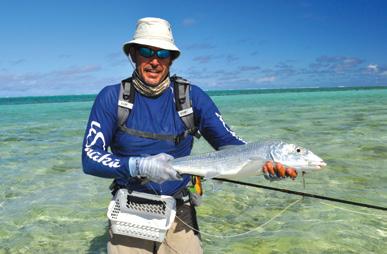
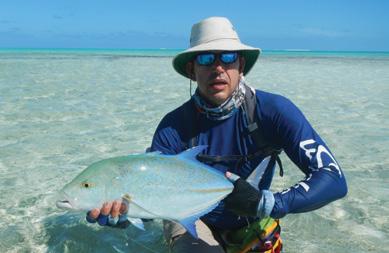
“LINE MANAGEMENT IS THE MOST IMPORTANT THING IN FLY FISHING, NOT THE PRICE OF YOUR EQUIPMENT.”
The biggest adventure I’ve ever been on involved my glass-eyed mate and his 12-foot sailboat, well a dinghy really. Four of us thought it would be cool to sail up to Inhaca Island, Mozambique for the Easter weekend as part of the annual Inhaca Island Yacht Race. Joe had his skipper’s licence and I had sailed a bit, but Mark and TJ didn’t know their jib from their mainsails. “They’ll learn quick enough,” said Joe. Soon after leaving the Richards Bay harbour, a monster southerly wind came through, TJ and Mark succumbed to seasickness and retired to the cabin. Joe and I sailed that tub in the worst conditions for two days and two nights, eating peanuts and raisins all the way to Inhaca. The only time we saw the rest of our “crew” was when they opened the hatch to vomit at our feet. Race organisers announced yacht Fairwinds “unaccounted for”. We eventually got there and had a jol at Inhaca, then had another nightmare coming home. But that’s a longer story. I still have the medal but we came home last, a day after the other contestants. We did get a special bravery award, but that’s where I learned that there is a very thin line between “bravery” and “stupidity”. Joe sold Fairwinds (so named because that’s what it needed) shortly thereafter. The other big adventure involved trying to see a green-headed oriole on Mount Gorongosa in Mozambique. Another long story.
The best way to face one’s fears is with sage advice from your elders.
Before I die I would like to catch a spotted grunter on fly. No, seriously, I would love to fish and bird in the Amazon. To be casting to peacock bass and have flocks
of red and blue macaws coming to harvest kaolin from the riverbank around us, is number one on my bucket list.
I believe fly fishing has many stages, it certainly has in mine.
Stage 1 . You want to catch a fish, any fish.
Stage 2 . You want to catch lots of fish, it’s all about the numbers.
Stage 3 . You want to catch big fish; it’s all about the Facebook post.
Stage 4 . You want to catch many different species; it’s all about the exotic locations.
Stage 5 . You just want to go fishing; it’s the escape from mundanity that restores sanity.
I believe that I am now in Stage 6, where I get great satisfaction out of guiding and watching other people catch fish.
If I could change one thing in fly fishing, it would be to convince people to keep the fish in the water, in the net. Remove the fly and wait until its gills have slowed down, and when your camera is ready, only then lift the fish out the water. I’d also teach people that line management is the most important thing in fly fishing, not the price of your equipment.
Looking back on my life thus far, the only thing I’d do differently is catch a spotted grunter.
Something I have changed my mind about is whether spotted grunter can be caught on fly.
The last fish I caught was not a spotted grunter!
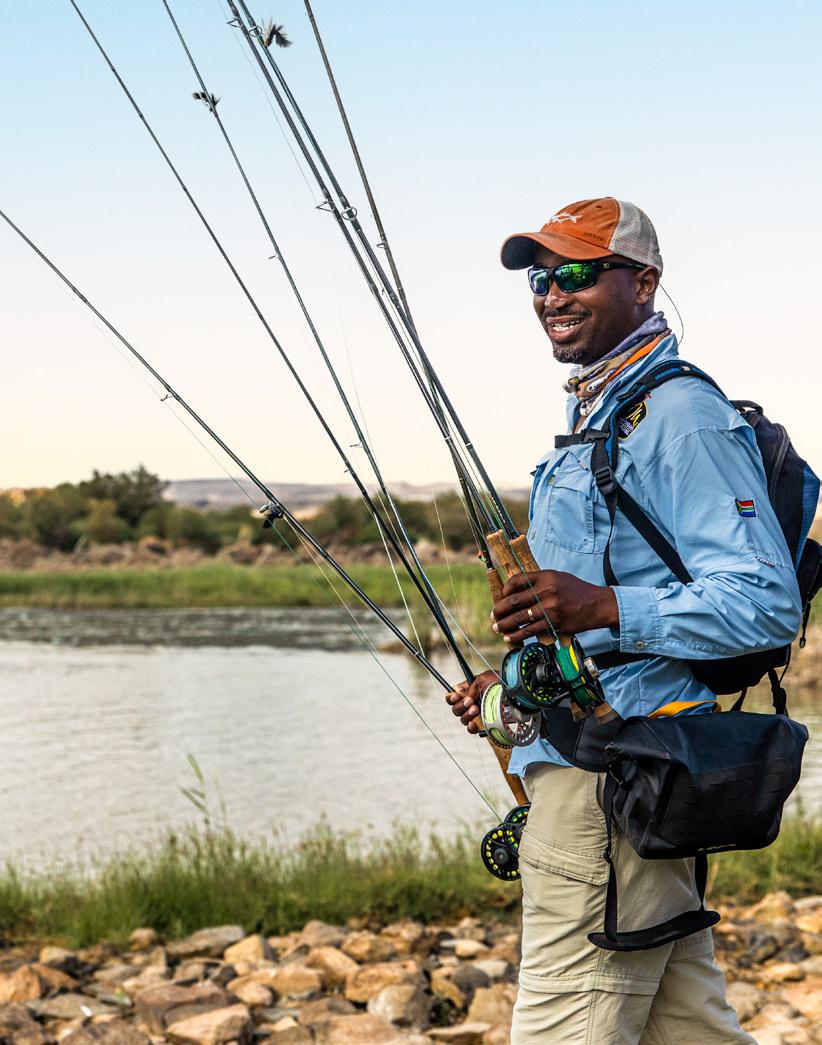




POP QUIZ
FISH-CATCHING WEAPON OR UNSECURE SIGNAL CHAT CHUMP? KING OF THE ALL-CAPS BOAST OR UNDERSTATED TOWN TOAST? TAKE OUR RAPID-FIRE QUIZ TO SEE IF YOU PICKED UP ANYTHING FROM THIS ISSUE, BESIDES ISSUES.
1. The man behind our Beats playlist, Brett Bellairs, is best known... (page 18)?
A. As Brett Bell-end.
B. For running Cape Town’s best indie art gallery.
C. As the rhythm guitarist on Wendy Ho’s smash hit, Poop Noodle
D. For eating a boerie roll in slow motion in our Golden Threads Orange River video.
E. For throwing a shoe at George W. Bush in Baghdad in 2008.
2. When would our High Fives guide David Taylor use the Gen-Z/Gen-Alpha expression, ‘Yeet’ (page 22)?
A. On the flats as it’s what his speech impediment makes, ‘Geet’ sound like.
B. It describes the sound a Clouser makes when connecting with fleshy parts of the anatomy.
C. It’s the involuntary noise you make when pulling on an anchor rope connected to a mangrove at Sette Cama.
D. It’s how he describes casting a 12-weight sink-tip line.
E. It’s what he would do if he could get his hands on the global supply of brass beads and a bottomless hole.
3. What has marriage brought an end to for Andre van Wyk (page 82)?
A. His OnlyFans career.
B. His semi-nude cover modelling for The Mission.
C. Friday nights spent wearing denim cut-offs and picking up R5 coins on Promenade walks.
D. The ability to speak in the singular.
E. Performative flatulence.
4. The Kitich Valley is home to what rare animal (page 44)?
A. Delilah’s Turaco.
B. De La Soul’s Catfish.
C. De Brazza’s Monkey.
D. De Sousa’s Trouser Snake.
E. Da Costa’s Skink.

5. In James Topham’s experience, people called “Brent” are (page 28)?
A. Crude and kind of greasy.
B. Really awkward managers who moonlight as solo artists.
C. Into swinging and some light BDSM.
D. The keyboardist for the Grateful Dead.
E. Younger than 30 and working in a surf shop.
6. According to Tudor Caradoc-Davies, which of the following is likely to get headbutted in the Nottingham Road area (page 34)?
A. Black woolly buggers with tungsten beads by big brown trout.
B. The pots in the pub of Notties Hotel by the chaps from head office.
C. Anyone who brings up the Teichmann/Skinstad saga of ‘99.
D. Fiat bakkie drivers.
E. Boets from rival trout town, Dullstroom.
7. According to Wayne Haselau, casting spirulina flies to milkfish is like... (page 56)?
A. Tossing lightly-steamed long-stem broccoli into a vegan moshpit.
B. Casting cauliflower Clousers into a crop circle.
C. Throwing a kikuyu fly on a soccer field.
D. Presenting purslane patterns in a paddock.
“Like sands through the hourglass and head office headbutting the Notties Hotel pub’s brass pots, these are the days of our lives.”





www.gkhuigkhui.com info@gkhuigkhui.com

F Y N B O S F I S F Y N B O S F I S


S H R E V I V A L S H R E V I V A L



Every great adventure begins with a journey, and Alu-Cab’s vehicle accessories make your journey better. Chase down untracked beaches, travel across untamed terrain and explore untapped big water. Because the best stories aren’t just about the catch – they’re about the search.


